Free Editable Narrative Writing Graphic Organizer Examples
Creativity and writing go hand in hand and are some of the most demanding skills for everyone. We always look forward to our kid's progress in the creative writing classes and workshops. There is so much to teach, from vocabulary to structure and idea generation. So, our job is to make this a pleasant experience for the kids to enable them to learn what they are bound to enjoy. A narrative writing graphic organizer is a creative way to learn narrative writing without overwhelming the students.

1. What is a Narrative Writing Graphic Organizer
In personal narratives, organizing thoughts and ideas before starting writing is a crucial step. Narrative graphic organizers are perfect tools to help the students dig down into the key details and explore their thoughts and ideas. Narrative writing graphic organizers are helpful in both completing writing projects and also for reference in future projects.
Narrative writing graphic organizers are very supportive in creative writing because they save time and efforts for students and the teachers. Their focus is to divide the whole exercise into small chunks and allow the child to fill in details to come up with a complete recount or narrative of events and ideas.
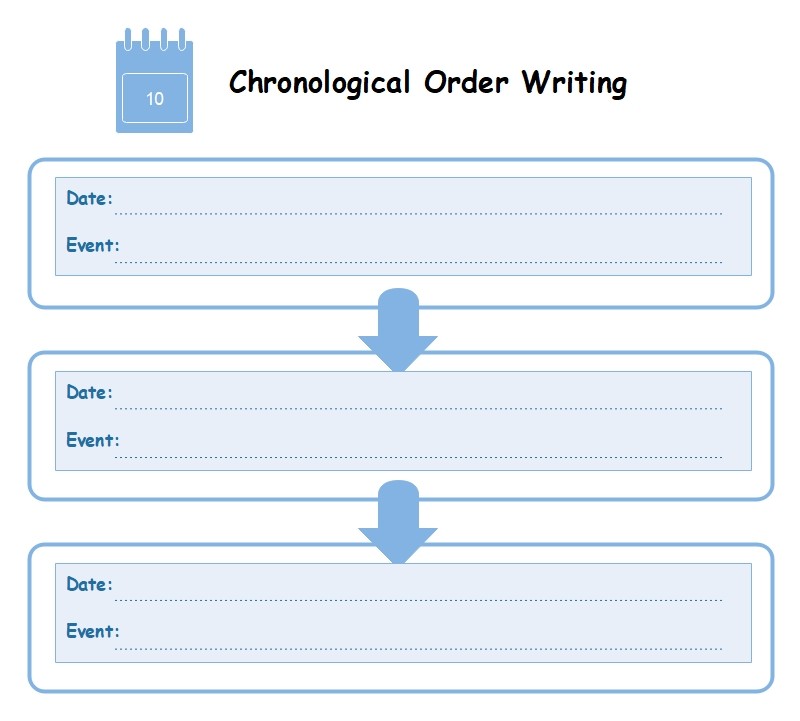
2. The Narrative Writing Graphic Organizer Examples
Below are 9 editable narrative writing graphic organizer examples for you to choose from.
Example 1: Writing Personal Narratives: Watermelon Graphic Organizer
This Watermelon graphic organizer is used to help students brainstorm a big narrative idea. Students divide their writing into small moments. They narrow down their report of significant moment experience to specific small moments. Watermelon narrative writing graphic organizer is presented as a fun template. They think of a watermelon slice as an event, while the small moment details are the seeds. This way, students do not get overwhelmed with the scale of more information. So, they start small and build their narrative gradually.
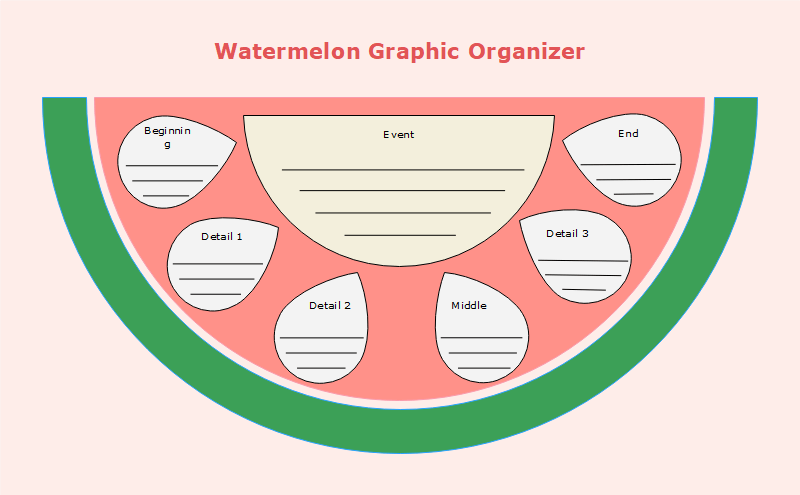
Example 2: Narrative Writing Graphic Organizer Template
Narrative writing graphic organizer template is a graphic organizer for students to create a personal narrative story. In this template, students first summarize the details of what they are going to write. This summary may include what happened, where it happened when it happened, and who the characters are. Students then add the details in the form of the beginning, middle, and end sequencing format. This graphic organizer for narrative writing template is incredibly supportive in writing biographies, travelogues, and event descriptions.
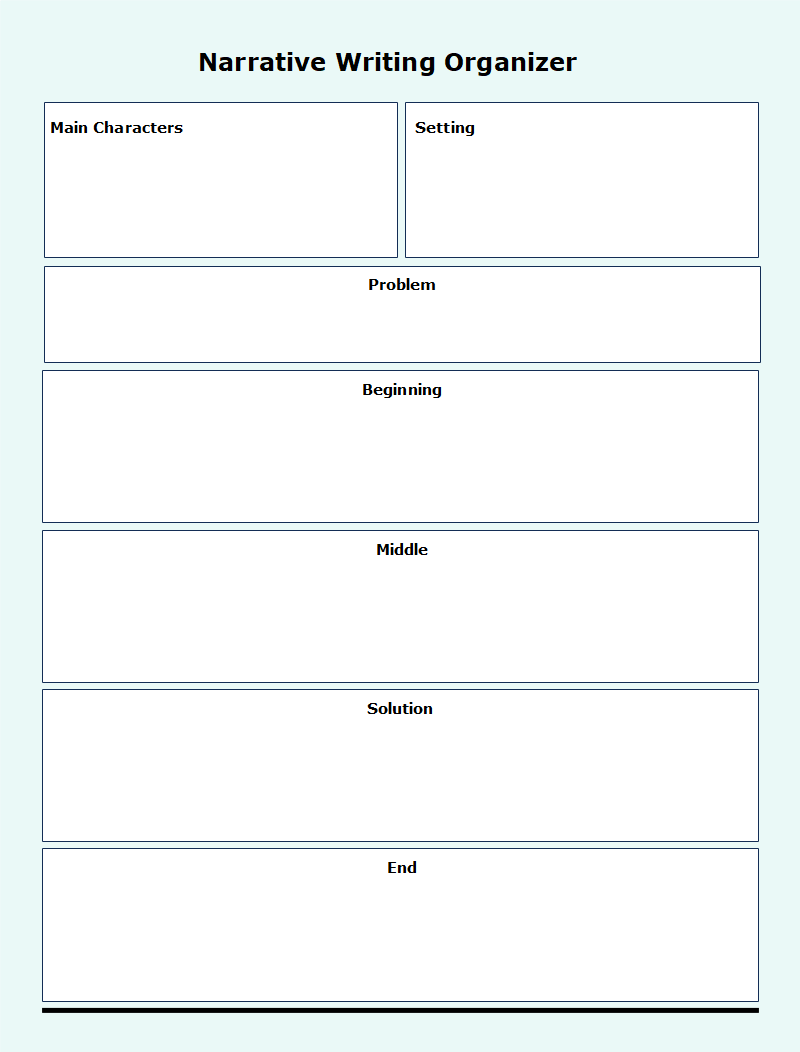
Example 3: Narrative Writing Brainstorm Graphic Organizer
Personal narratives are complicated for many students because the structure is not very particular. Narrative writing brainstorm graphic organizer is a sequencing guide for students to follow this structure for brainstorming, listing out characters, settings, event sequencing, and sensory details.
This narrative writing graphic organizer follows this structure.
- Brainstorming
- Who did it, when did it happen, where did it happen?
- What happened at the beginning, middle, and end of the event?
- Students dig deeper into details of the event along with sensory information.
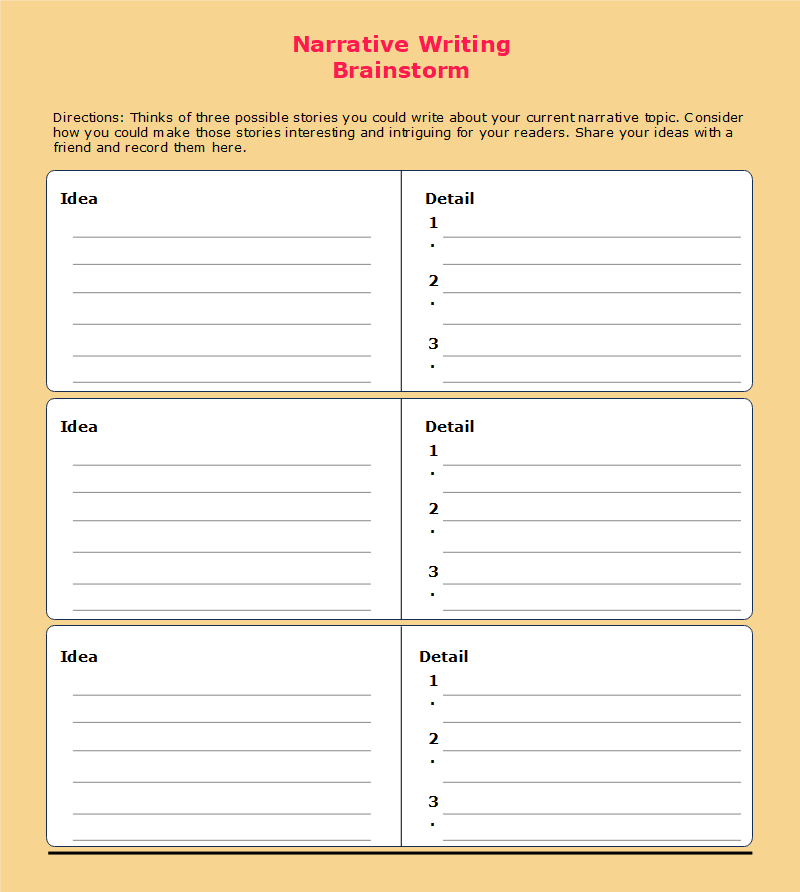
Example 4: Personal Narrative Graphic Organizer interactive worksheet
Personal narrative graphic organizer interactive worksheet is also based on the description of small moments. This worksheet starts with the small moment event. Then there are some questions pushing the student to give details of their memory. It asks 'who is in this story with you?', 'When/Where does this take place?' emotions, feelings, and sensory details. Later it asks for an attractive first sentence and then the details of the memory. Finally, the conclusion is written. So, in small steps, students can come up with a complete personal narrative. You can see the importance of graphic organizers for narrative writing in guiding the students without overwhelming them.
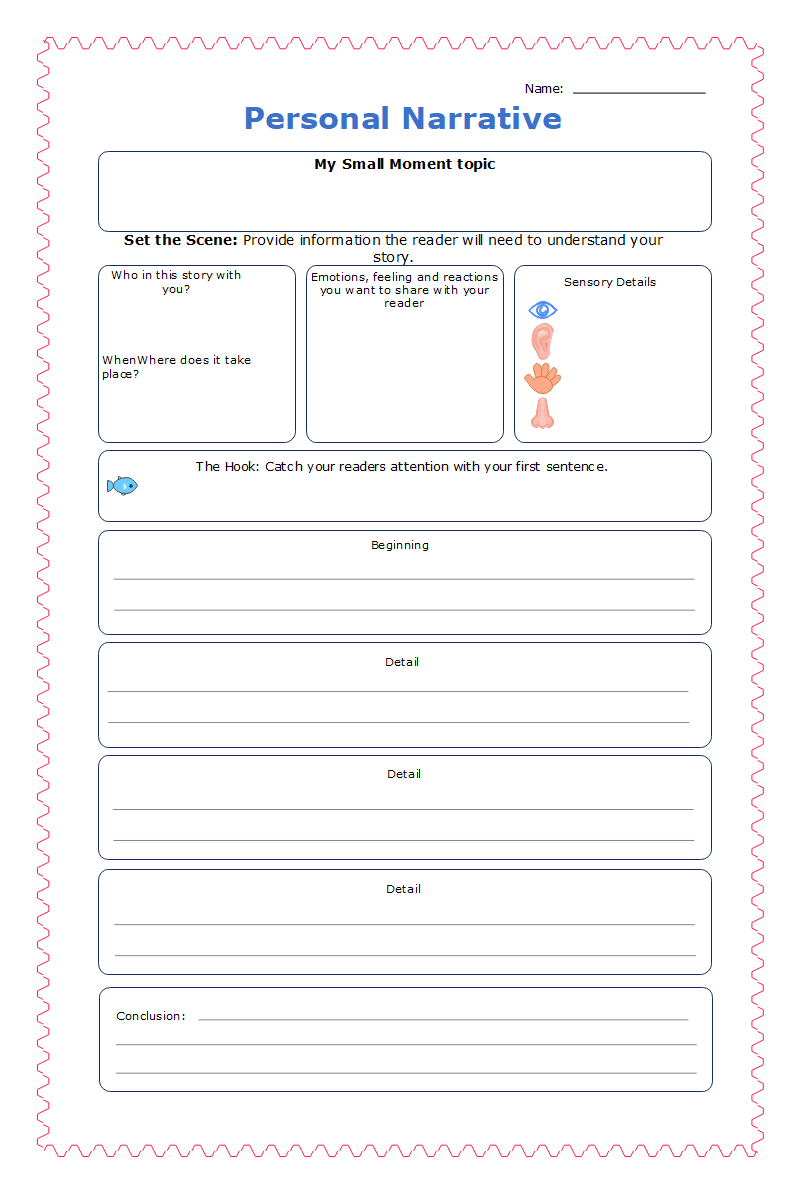
Example 5: Narrative Writing Graphic Organizer Example
This narrative writing graphic organizer example presents the student with some blocks for filling in the details. This is also a great tool to support the students to write a detailed account of a problem situation gradually with small stepping stones. This organizer first asks for the character descriptions, setting to describe when and where the event happened, the problem, and the solution.
The next step is the plot, where the students will fill in the start, building, and the end of the event.
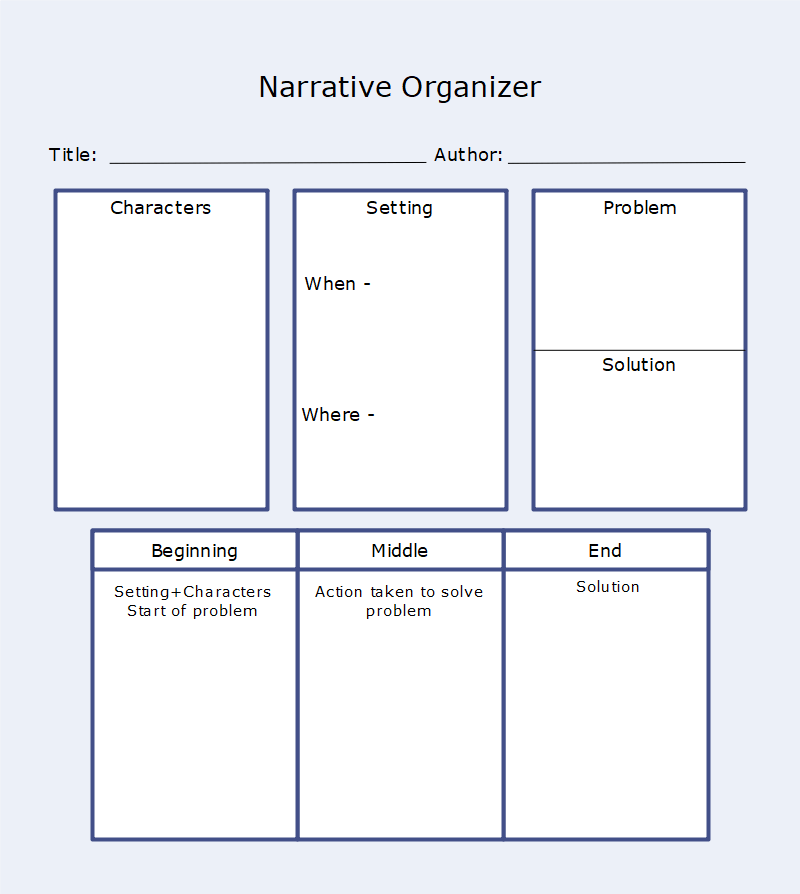
Example 6: Graphic Organizer for Narrative Writing
A graphic organizer for narrative writing is a perfect solution for young students in the early grades. This narrative writing graphic organizer is the simplest form of an organizer. It starts with the title, topic, and purpose. Then we ask the students to write the first catching sentence. Followed by the first sentence, we want the details of the event in three steps. Write the first, next, and the last piece and end it with the conclusion.
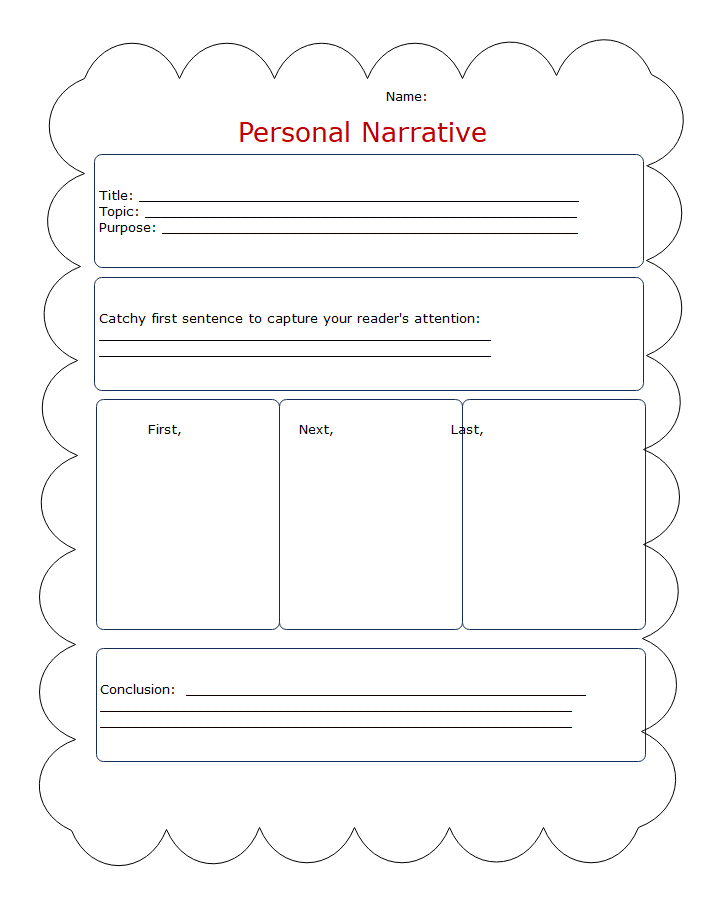
Source: EdrawMax Online Edit Now
Example 7: Narrative Writing Planning Graphic Organizer
This graphic organizer for narrative writing is an organizer that focuses on sensory details. It asks the students to draw their narrative scenes and then recall the smell, taste, feels, hears, and what they saw in that event. So, this recount is more about the feeling than the words.
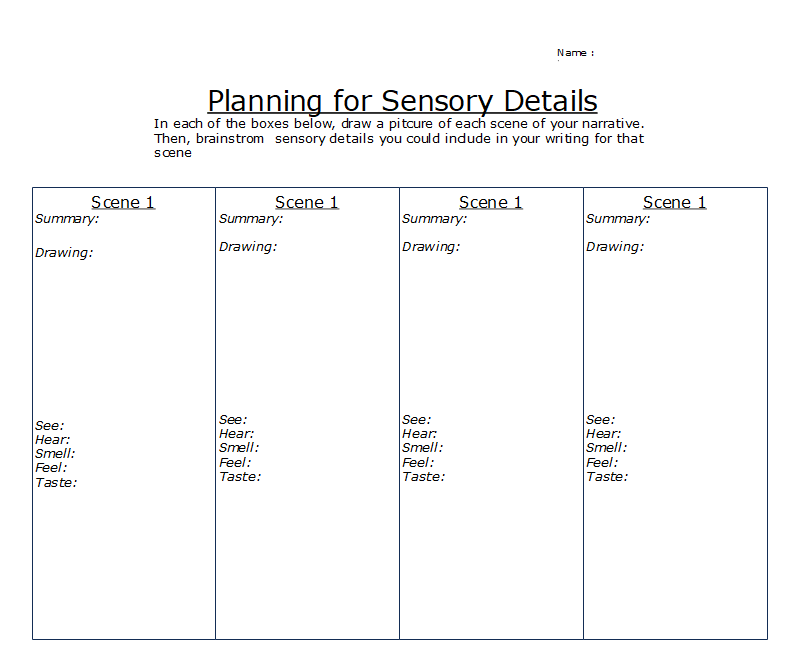
Example 8: Narrative Writing Graphic Organizer: Beginning-Middle-End
Narrative writing graphic organizer is suitable for students with command over written words and vocabulary. It again calls for the beginning, middle, and end of the event. The student can go step by step on the recount of the event and describe what happened. However, it lacks particular boxes for characters and settings. In the end, the students fill in the last box with the summary.

Example 9: Narrative Writing Graphic Organizer Middle School
Online narrative writing graphic organizer is another simplest form of a graphic organizer. It simply asks the students to fill in the introduction, middle, and conclusion. For the lack of more prompts, we can assume that this organizer is again more suited for the older student who has command of writing and vocabulary. As the name suggests, this is for middle school students.
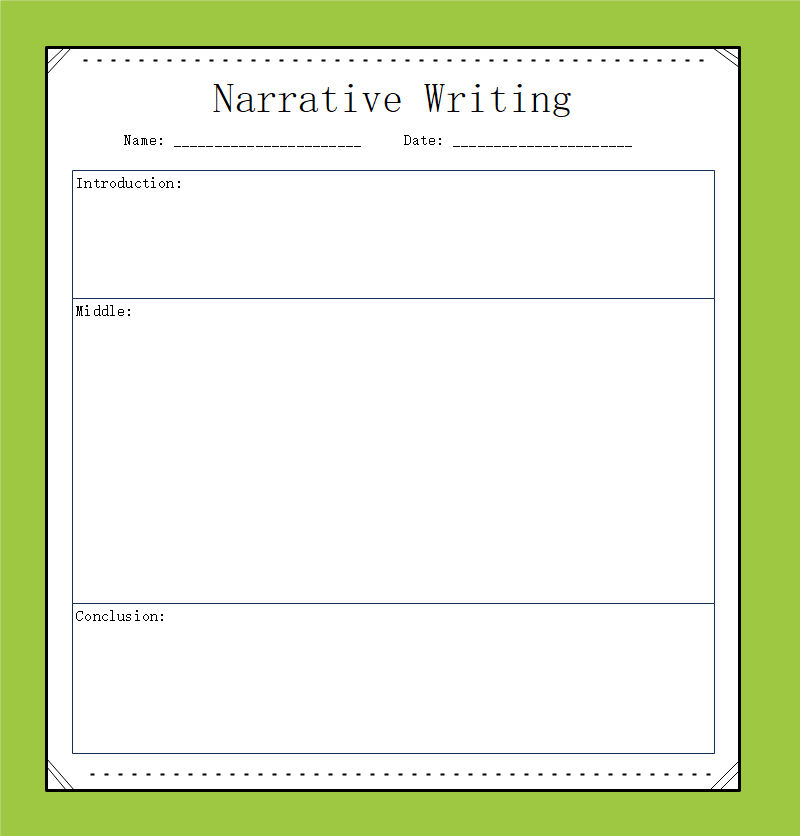
3. Online Narrative Writing Graphic Organizer Maker
A Graphic organizer maker is an excellent tool for teachers and mentors to create narrative writing graphic organizers according to the needs and skills of their pupils. EdrawMax Online is a robust tool for quickly creating graphic organizers in little time. Since the teachers are very busy and need easy-to-use tools to support their teaching endeavors, EdrawMax Online is excellent support. The best part of this tool is the availability of pre-made templates that can be used right away and customized. There are templates available at Template Gallery for more than 280+ types of drawings.
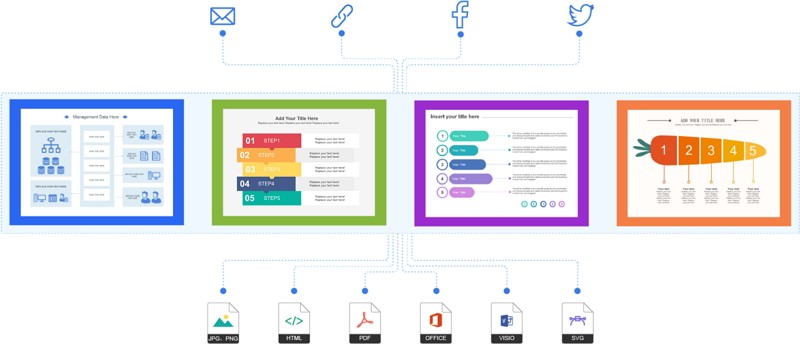
4. Key Takeaways
Graphic organizers for narrative writing support teachers, parents, and students for tension-free creative writing. Children love to tell their stories and experiences, but when we force them to follow a particular structure, writing style, and vocabulary, it becomes a stressful situation. Narrative writing graphic organizers support this situation and present fun solutions for making creative writing stress-free.
EdrawMax Online is a quick-start graphic organizer maker that makes making graphic organizers very easy and less time-consuming. It has many shapes, symbols, and text tools for drawings. The templates available at Template Gallery make the tasks even more accessible.
Related Articles

Low-Prep, Standards-Based Resources for Upper Elementary

The Secret Weapon to Powerful Narratives? Try Graphic Organizers!
Use graphic organizers to plan and draft powerful narratives.
By Marianna Monheim updated October 25, 2023
Characters, plot, and setting…oh my!
Narrative writing does not come naturally to most of our upper elementary students. The act of writing can seem difficult and time-consuming, and many students become frustrated after writing a sentence or two! This is why emphasizing the writing process is essential. Once students begin to spend more time in the planning and drafting stage, the actual writing of a narrative will be a breeze.
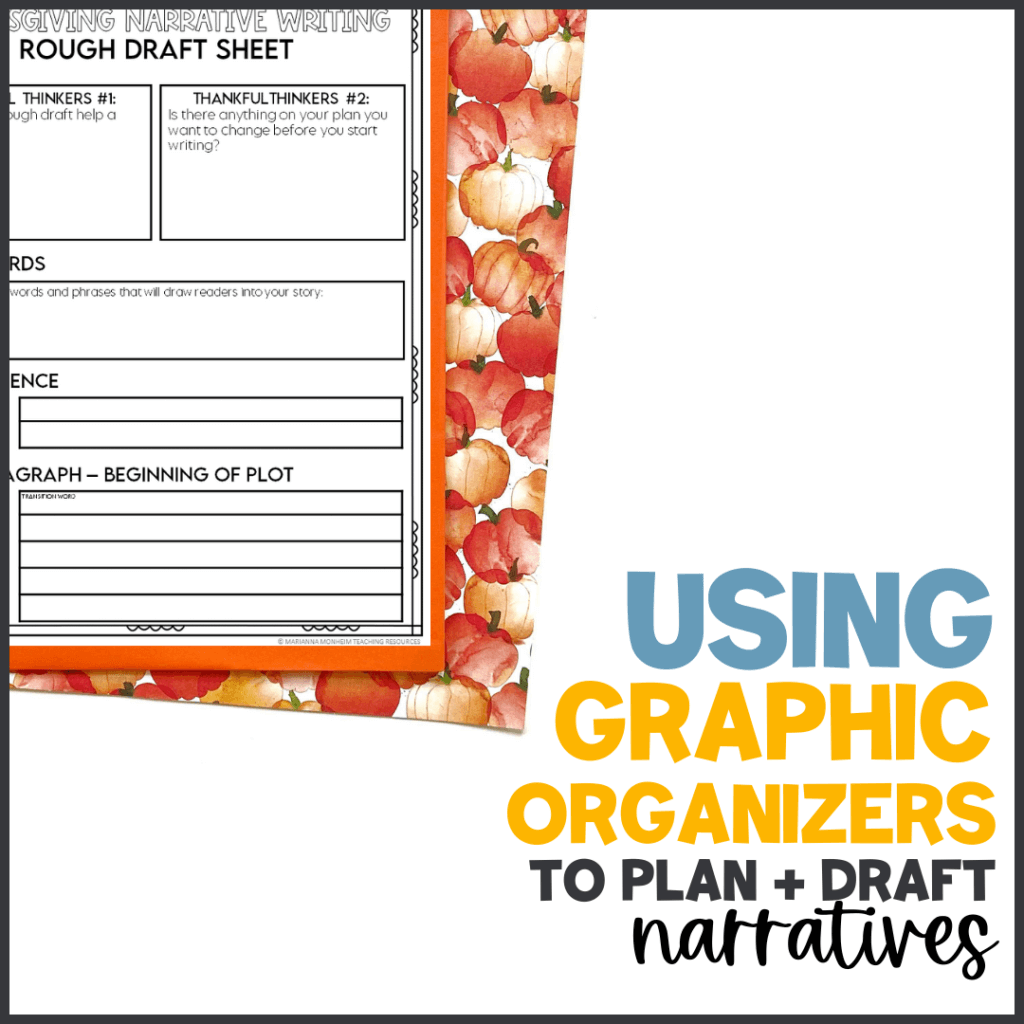
It’s no secret that I’m a big fan of graphic organizers for reading. Did you know they can be just as effective for helping students plan and draft while writing? Narrative writing graphic organizers not only help students keep track of important story elements, but also show when and where each element should be focused on!
The Crucial Role of Planning in Narrative Writing
Planning is the blueprint of narrative writing. It’s where students decide on their story’s setting, characters, and plot. However, without a structured approach, planning can become chaotic and counterproductive.
Unless students are avid readers, they will not have an intrinsic understanding of each story element’s role in a narrative. Therefore, when developing graphic organizers, it’s important to go beyond just a box for characters, one for setting, and one for plot . In stead, have students create detailed character descriptions that include both “inside” and “outside” traits. Then, have them use those descriptions to think about how their characters will react to the events at the beginning, middle, and end of the plot they’ve created.
Don’t forget the setting! The time and place a story is set in have huge implications for the plot. Help your students see that all these choices combine to create powerful storytelling .
The first time you introduce the idea of detailed planning, it may not go over so well! We know our students just want to do something once and be done with it. However, with repeated practice, they will begin to see the benefits of spending time on their narrative plan.
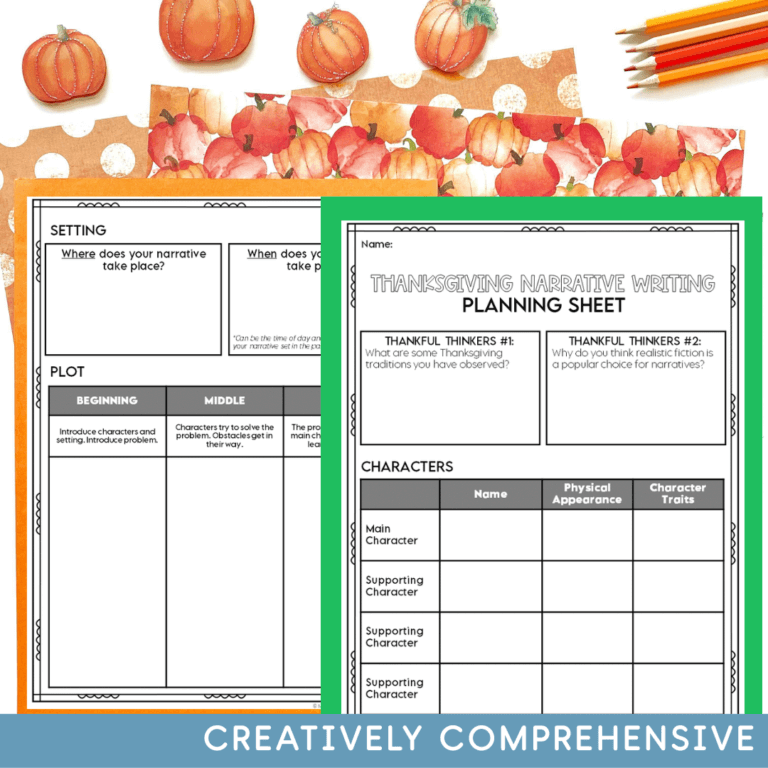
Narrative Rough Draft - Putting Things Together
Rough drafts can be frustrating for students- but they don’t have to be! Using a structured organizer to help students plan is one of the most beneficial things you can do to turn your students into writers.
You see, I used to help my students plan…then send them off to draft on their own. The problem? They aren’t sure how to translate the plan into paragraph form . Utilizing a graphic organizer at this point was a game changer. By breaking elements down paragraph by paragraph , students could see how a plot should develop , and how their characters should change from beginning to end . In addition, they focused on organizational elements such as transitions during the drafting process, instead of when revising and editing.
When we frontload students and make sure they have the necessary components to their draft, they don’t feel like they have to rewrite their entire essay when it’s time to revise. Then, it becomes easier for them to focus on other elements such as word choice and sentence structure.

Creativity + Structure = Success
Some may argue that graphic organizers will limit the creativity of students when writing a narrative. My response: understanding and applying the basics of story structure is important . I want my students’ amazing output to be understood by their readers . For most students, a great deal of scaffolding is needed to get to that place. Graphic organizers can help you to achieve that scaffolding .
Engage Students with Holiday Narrative Writing Fun

Holidays (like Thanksgiving) are a great time to indulge in some narrative writing fun. This step-by-step resource (including the graphic organizers seen above) has students use their memories of past Thanksgivings to create a realistic fiction narrative. The best part? Students get to color while revising and editing!
This resource and other holiday narrative activities can be found in my TPT store .
Related Posts:

Boost Creativity and Spark Joy: Halloween Writing Activities in the Classroom
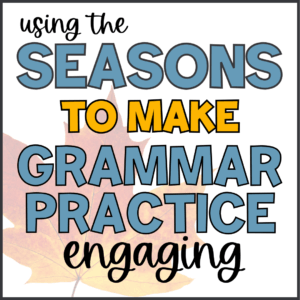
Add Seasonal Fun to Make Singular and Plural Nouns Practice Engaging
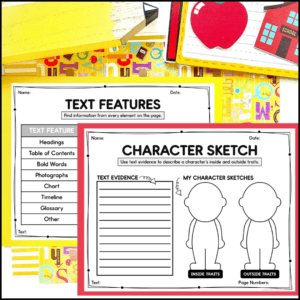
Graphic Organizers
WANT ACCESS TO MY FREE TEACHER RESOURCE LIBRARY?
One room schoolhouse.
Once Upon a
EXCITE | ENGAGE | EDUCATE
- Apr 3, 2022
The Power of Graphic Organizers for Narrative Writing

If you know me OR have been with me for a while, you likely know the love affair I have with graphic organizers. And specifically, graphic organizers for narrative writing.
In writing, graphic organizers are an important step in the prewriting process. They are sometimes referred to as "thinking maps", "concept maps", "knowledge maps", or "cognitive organizers". Essentially graphic organizers are a, well...graphic, or visual, representation of understanding. They can focus on fictional or factual information and are used ( or should be) in every aspect of the school day for students of ALL AGES. Reading? Yep! Writing? Absolutely! Math? Check! Social studies? Yes! Science? Sure! Even...physical education? Definitely!
Here are a couple of examples of graphic organizers we see everyday.
Even as adults we use graphic organizers. Have you ever seen the bracket for basketball's March Madness or for a fantasy football league? Those are graphic organizers called tree maps. How about the directions for putting together a piece of furniture? The kind with the pictures for you to follow. Yep. You guessed it. That's a graphic organizer too. It's called a flow chart. What about a marketing plan for business? That's a concept map.
I could go on and on, but I think you see where I am going. Graphic organizers are everywhere and they make our lives easier. They can make your students' lives easier too, as well as turn reluctant writers into avid writers.
GRAPHIC ORGANIZERS FOR WRITING
Graphic organizers for writing are a MUST-HAVE for any successful writing program. To ask students to write without giving them a tool to help them to brainstorm is cruel and unusual punishment in my opinion. As an adult I NEVER write without doing some sort of prewriting organizing, and I have been writing for ages. I have had a ton of practice but our students...they've had only a few years to practice and they're still learning. Asking students to write without an organizer is like asking them to write without a pencil. It makes no sense.
They need an organizer.
DIFFERENT KINDS OF NARRATIVE WRITING
There are dozens and dozens of graphic organizations available for narrative writing to choose from. These maps and organizers help young writers gather, compose, and formulate their thoughts for any number of narrative writing text types such as:
Factual Narratives
Autobiography
Diary or Journal Entry
Fictional Narratives
Creative Fiction
Realistic Fiction
Science Fiction
Adventure Tale
Fractured Fairy Tale
Comic/Graphic Novel
Fan Fiction
Let me show you what I mean. Here are a few examples of graphic organizers in action with some of my own students-kids who were self-proclaimed haters of writing until they came to me.
FIFITH GRADE FLOW CHART
Below is an example of a flow chart that I used with one of my fifth graders to organize her thoughts around how to structure a day in the life of a young girl in Colonial America. The pictures show how she used flow chart, the graphic organizer, to construct a fictional day for her character, Isabella.
At the top of the organizer you can see that the student has named her character, including noting her pronouns, and identified both the time/era and the setting; Virginia on a tobacco plantation in 1632.
The flow chart also details the events that are to take place throughout the character, Isabella's day from morning until bedtime. Not only does this flow chart indicate the extensive research that this student did but it also clearly shows her understanding of the history of the time as well as her understanding of narrative writing. With this one organizer it is easy to assess this student's understanding, comprehension, and mastery of numerous grade-level standards for fifth grade.

The narrative writing shown below, is the student's translation from the flow chart to the journal entry writing task detailing a day in the life of Isabella; an 11-year-old girl living with her family on their tobacco farm in Virginia. In it, there is no doubt that the student's focused work using the graphic organizer contributed to the success of this realistic fiction narrative.
Although there are many more steps in the writing and editing process to be done before this story could be considered "finished", the story that this student created is captivating and draws the reader in from the first sentence. The young author's voice is authentic and full of the kinds of details that make this writing interesting and successfully executed.

FIRST GRADE STORY MAP
Below is an example from one of my first grade students. The picture shows him working on retelling the story of The Three Billy Goats Gruff using a story map. (In the older grades, a story map is often called a plot diagram.). Although, technically, summaries are considered informative writing, this is still a great example of how to use a graphic organizer to help shape great writing.
We began this writing lesson by reading Little Red Riding Hood and reviewing the parts of a story-the characters, setting, beginning, middle, climax, and end. The familiarity of rereading a known fairy tale allowed this little guy to focus on the parts of the story that he was asked to write about. The organizer used was the first step for him and a way to organize his thoughts before attempting to write a one-paragraph story summary.
This organizer can also be just as easily used, now that this student is familiar with story structure and how to use this particular organizer, to create his own original story. The best graphic organizers are open-ended enough to be used for both reading and writing with narrative and informational texts!

SECOND GRADE VENN DIAGRAM
Next is an example of a second grade student using a writing/thought organizer called a Venn diagram. In this instance he is using it to compare and contrast two characters in a chapter book that we had been reading; Horrible Harry Moves Up To Third Grade by Suzy Kline.
As in the fifth grade example, there is a lot more going on here than just filling out the graphic organizer. This second grader is using his comprehension of the chapter book to analyze his characters. Who they are. What they value. What their actions are and how those actions tell the reader what kind of person they are. The organizer helps get this student moving in the right direction and acts as a "parking lot" for him to construct his thoughts.
Once the student understands what makes the characters in his book tick, he can use what he knows to write a response similar to the diary or journal entry that my fifth grader wrote in the first example.

SECOND GRADE BUBBLE MAP
This last example is from the same second grader as above. This time he is using a bubble map to outline the important events from chapter 1 of Horrible Harry Moves Up to Third Grade by Suzy Kline. He is using the events (and looking for text evidence--you can see the highlighter strip on the page) in the chapter to set himself up for his narrative writing task in which he will be writing the beginning scene, or event, of chapter 2 before actually reading chapter 2.

Again, this is a great example of the versatility of an open-ended graphic organizer. This young writer is using it to reinforce his comprehension of the text as well as set himself up for the narrative writing task to come. Bubble maps are one of my favorite organizers because they are so easily adapted for different purposes. They are also easy to recreate on a blank piece of paper in a pinch!
If you'd like to explore some of my other graphic organizers OR grab one of my organizer packs, click the thumbnail pictures below.

And, explore my FREEBIE LIBRARY to grab some of my free teacher resources including the story map seen in the picture above. For exclusive access, all you need to do is subscribe to my weekly newsletter . The password is will be sent out on Tuesdays in the newsletter!
Happy writing, my friends,
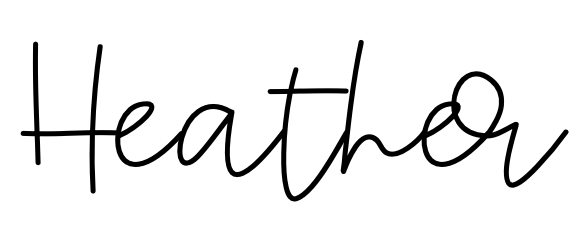
Recent Posts
What the Heck is the Instructional Writing Sequence?
Taking a Deeper Dive into Narrative Writing
How to Teach Writing Using Biographies, Autobiographies, & Memoirs

Component Parts of a Narrative Writing Piece
A narrative piece is usually written to tell a story of actual events. Students typically write about trips, experiences, lessons learned, adventures they want to go on, or things they did over the weekend. As they map out their writing, using a narrative writing graphic organizer can help them organize their thoughts. This is typically how a narrative writing piece is formatted:
- The writer introduces the setting and characters or people involved.
- They provide a hook to grab the reader’s attention.
- The main character’s goal is often displayed.
- The writer develops the conflict or problem if there is one.
- The roles of key characters are brought to light.
- Any tension is built up to make the story exciting.
- Students introduce the turning point of the story.
- The reader will find most of the tension or conflict here.
- The moment when the main character makes a crucial decision or faces their biggest challenge is revealed.
- The conflict unravels.
- Minor plot points are resolved.
- The writer heads into the conclusion of the story.
- The central conflict is resolved.
- The story’s theme or message is reflected upon.
- Some satisfying or conclusive ending is given.
Remember that depending on the grade, some of these elements may be much simpler. As kids age, they become more complex, but the first narrative writing graphic organizer they use will be elementary.
Creating a Narrative Writing Graphic Organizer
- Plot Structure: Start by teaching students about the essential elements of a narrative. These include the introduction, rising action, climax, falling action, and conclusion. Encourage them to add sections for each element in their graphic organizer. This helps students visualize the flow of their story.
- Character Development: Ask students to include sections for character details, such as the protagonist, antagonist, and other main characters. Include spaces for character names, descriptions, and character traits. This will make it easier for them to add as they write their final draft.
- Setting Description: Allocate space for setting details, where students can jot down the time, place, and atmosphere of the story. Encourage them to be descriptive, painting a vivid picture for the reader, even while creating their narrative writing graphic organizer.
- Conflict and Resolution: Help students identify the central conflict in their narrative and a section for how it gets resolved. This will ensure the story has a clear, satisfying conclusion for readers.
- Dialogue: If applicable, suggest adding a section for dialogue. Encourage students to include speech bubbles or quotation marks in their organizer for meaningful character interactions, if there are any.
- Transitions and Sequencing: Teach students to connect their ideas using transition words and phrases. In their graphic organizer, they can include arrows, lines, or connecting words to indicate the sequence of events. They will recognize that those arrows or lines are places they need to use transition words in their final drafts.
- Sensory Details: Remind students to include sensory details in their narratives. Create a section for them to add smells, sounds, tastes, and textures that enhance the reader’s experience.
- Emotions and Thoughts: Encourage students to jot down the emotions and thoughts of their characters at different points in the story. This adds depth to the narrative and makes their writing more interesting to read.
- Title and Illustration: Include spaces for a catchy title and a small illustration. A well-chosen title can give readers a glimpse of the story’s essence, and a simple drawing can add a personal touch. After all, a narrative writing graphic organizer isn’t complete without a title.
Use Fun Narrative Writing Activities to Practice
Before jumping into full narrative writing, try exciting activities that get kids used to this writing style. A Roll and Write Game will encourage their creativity as they make up their stories. It will expand the way they think about story elements.
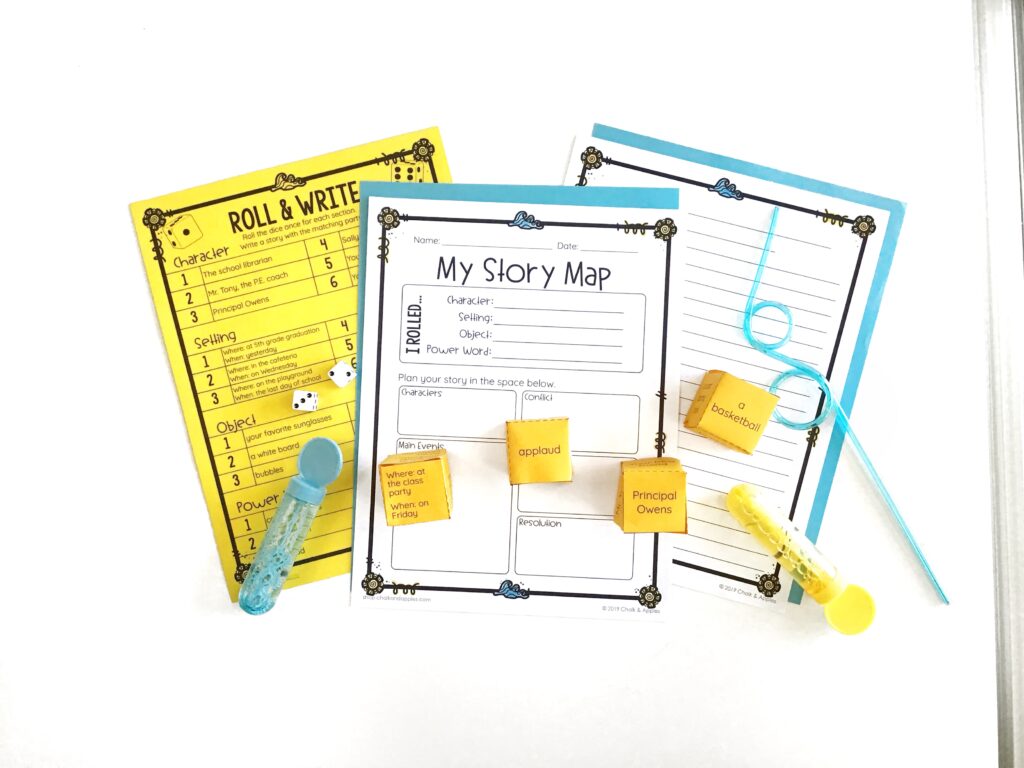
You can also have your students practice their narrative writing skills by writing weekly narrative pieces with these pre-prepared organizers. Once they start writing their own pieces, have them use the same format to make it easier. These are also available as digital files !
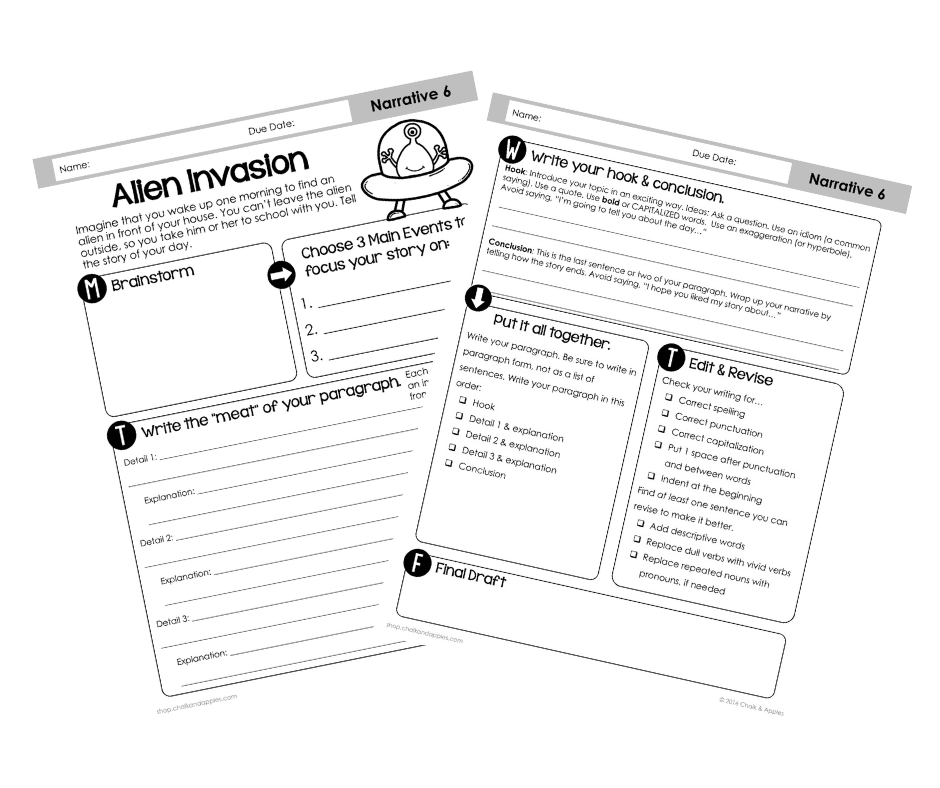
By helping upper elementary students create narrative writing graphic organizers and understand the essential components of a narrative, teachers can empower young writers to develop their storytelling skills. These tools and concepts will guide students in crafting engaging, well-structured narratives that captivate their readers.
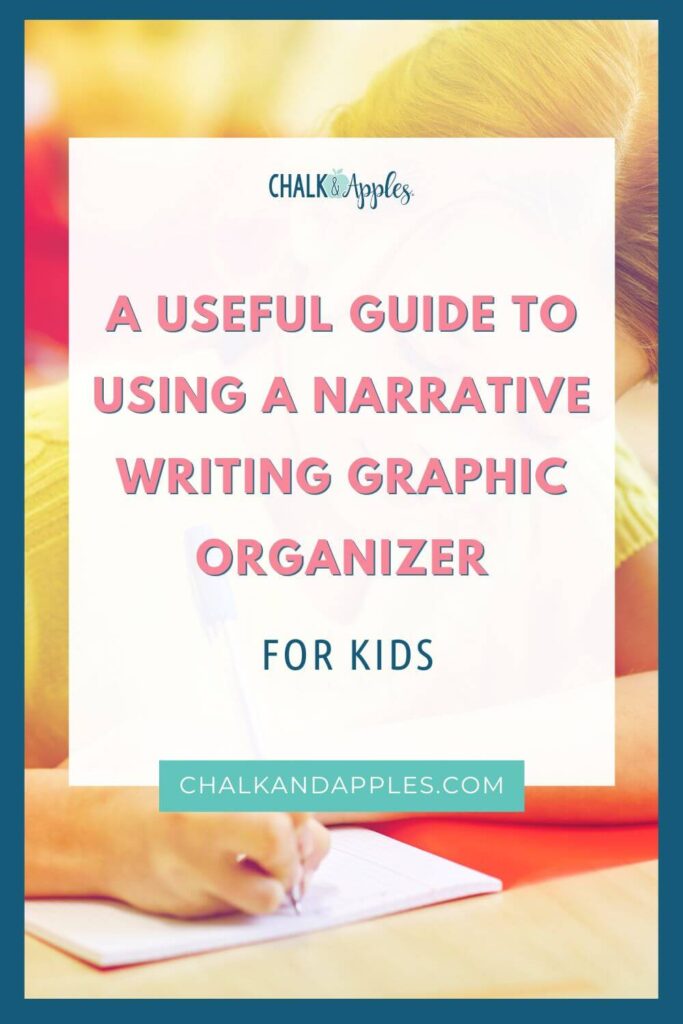
You might also like these posts:

7 Math Games Dice are Useful for in the Upper Elementary Classroom

Utilizing Classroom Centers in 5 Powerful Ways
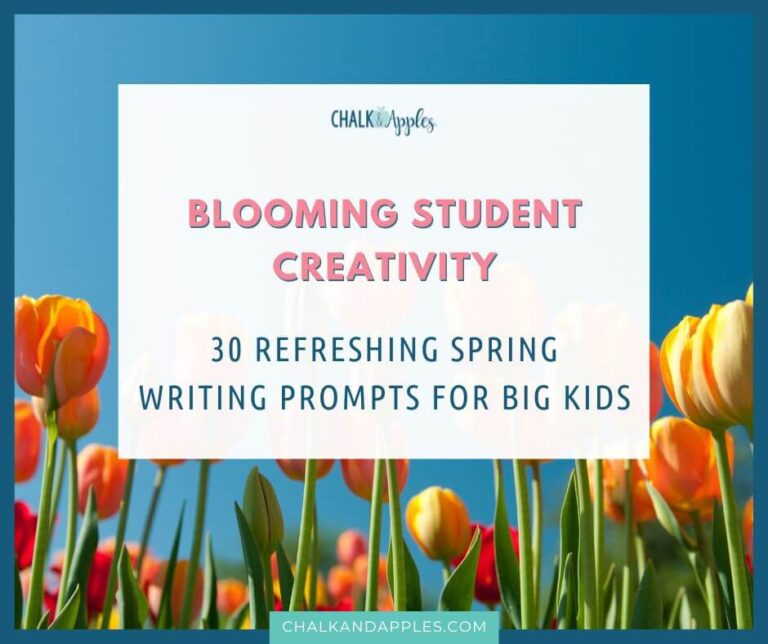
Blooming Student Creativity: 30 Refreshing Spring Writing Prompts for Big Kids

What are Text Structures Anchor Charts, and How Can Teachers Use Them to Their Advantage?
Shop teacher favorites.
Find ready-to-go lessons, activities, and organizational tools to simplify your life and help you fall back in love with your job.

Reading Digital Rotation Board with Timers (Editable)

Digital Rotation Boards for Reading & Math (Bundle)
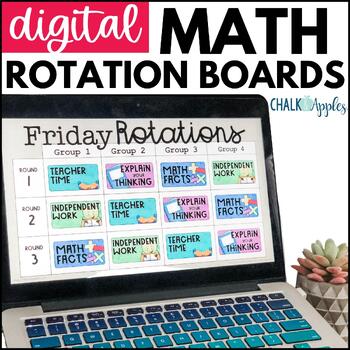
Math Digital Rotation Board with Timers (Editable)

Word Work for Big Kids: PRINTABLES for Vocabulary

Great Mail Race Complete Kit
Free teaching resources, join the newsletter.
Get teaching tips, resources, and freebies delivered right to your inbox once a week!
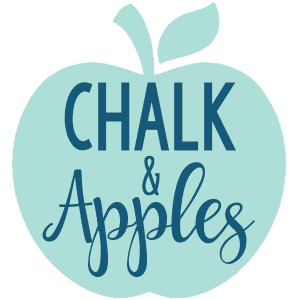
- Terms of Use
- Disclaimers
- Privacy Policy
- Resource Shop
- Access Purchases
The Community
We weren't meant to do this teaching life alone... we need each other. Join our Upper Elementary teacher community on Facebook for tips, ideas, and support from people who get it... teachers just like you!
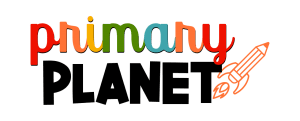
Free Resource Library
Classroom management, how to teach narrative writing with 3 fun writing graphic organizers.
Narrative writing was always my favorite type of writing to teach. The stories that my students came up with were AMAZING! The problem was, they always lacked organization, they would leave important parts out! They would have a great lead, but there was no problem in the story. Or, they had a problem, but no solution. Fortunately, I created something that helped us tremendously! Graphic Organizers! In this blog post, we’ll explore the benefits of using graphic organizers in the classroom and show you how to leverage them to improve your students’ narrative writing abilities. From types of organizers to tips for effective implementation, we’ll cover everything you need to know to empower your young writers. Let’s dive in!

Why Use Graphic Organizers for Narrative Writing?
Prewriting is an important part of the writing process ! Using a graphic organizer for prewriting is an awesome way to provide structure and organization for students. By breaking down their ideas into smaller pieces, young writers can more easily see the connections between different parts of their stories and make sure that they have all the parts that they need. This can be especially useful for students who struggle with expressing themselves through writing.
Narrative Writing Graphic Organizers
There are several types that can be used to teach narrative writing skills to young students. You can find tons of organizers using a simple Google search !
One option is to provide your students with paper that has a space for drawing. They can draw a picture of the parts of their narrative writing that they want to make sure to include!
Another popular option is the storyboard, which helps students organize their ideas into a clear beginning, middle, and end. This type can be especially helpful for students who struggle with structuring their writing.
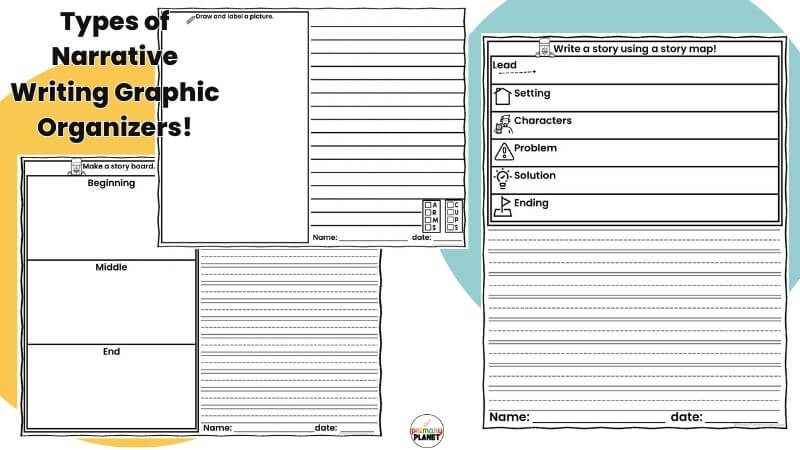
A Story Map can also be a little more detailed. This one is my favorite! It has spaces for students to jot down ALL of the parts of the story that they would like to write: Hook (or lead), Characters, Setting, Problem, Solution, and Ending. They get all of their ideas down on the page, then they start writing!
Would you like to try one? Sign up for my newsletter to get teaching tips, tricks, and FREEBIES!
There are also very specific organizers if you find that your students are struggling with a particular writing skill such as dialogue or writing a fairy tale!

How to Introduce Graphic Organizers in Your Classroom
Start with showing your students examples of different writing graphic organizers. Talk about what they notice about them, and ask your students how they think that they could be helpful to their writing.
Once you’ve introduced them, it’s a good idea to model their use. (I Do. Gradual Release of Responsibility Model ). Show your students step-by-step how to plan a story using the organizer of your choice. You can do this in one lesson (if you keep it moving along), or fill it out the first day and the next day, and show your students exactly how you use it to write the story. By modeling the process yourself, students can get a better sense of how they work and how they can be used to develop their own writing.
Then, it is always a good idea to practice using one together as a class (We do.) This lesson can move a little more quickly. Have the students help you to fill it with ideas for the story (it may be really silly, but then they will remember it!). Write the story together!
Finally, it’s important to provide opportunities for students to practice using graphic organizers on their own (You Do.). Start with the one that you modeled with your students. Let them use it by themselves or with a partner to write a story!
Tips for Using Graphic Organizers Effectively
Once you’ve introduced graphic organizers to your students, it’s important to ensure that they’re using them effectively. Here are some tips to keep in mind:
- Model, Model, Model! Make sure your students know how to use them before they will use them independently.
- Start with simple organizers. Once your students have mastered using the storyboard, they can move on to the story map!
- Use a variety of organizers. While it’s important to start with simple organizers, it’s also essential to provide a variety of organizers for your students to choose from. By offering a range of options, you can support different learning styles and help students find the organizer that works best for them.
- Provide feedback and support. As your students begin to use graphic organizers on their own, provide feedback and support to help them refine their skills. Encourage them to reflect on their writing process and consider how they can improve their use in the future.
By keeping these tips in mind, you can help your students become more confident in their use of graphic organizers to assist them with their narrative writing!
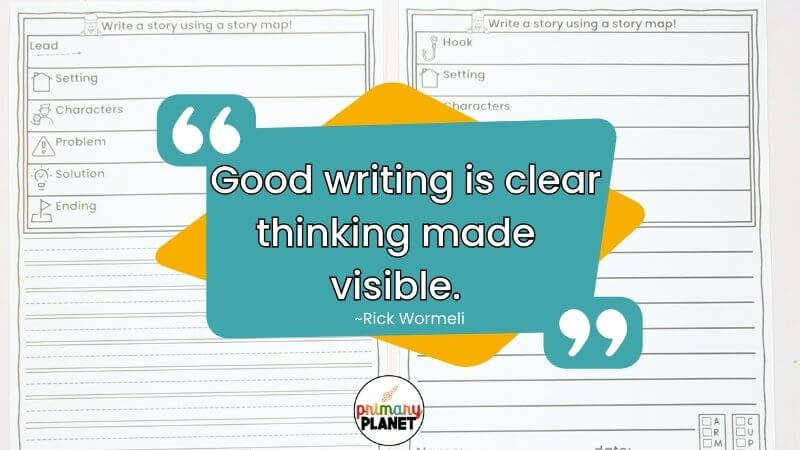
Using graphic organizers in your classroom can significantly improve your students’ narrative writing skills. By providing a visual aid to help organize their thoughts and ideas, students can develop critical thinking skills and craft fun stories! As author Rick Wormeli once said, “Good writing is clear thinking made visible.” Your students can make their thinking visible through the use of graphic organizers and watch as their writing skills soar.
Looking for the Organizers shown in this post? You can find them here:
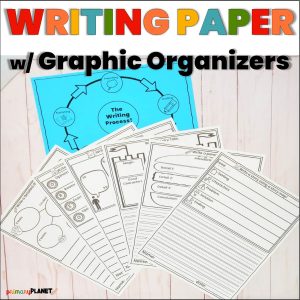
Thanks so much for stopping by and reading this post! Happy Teaching!
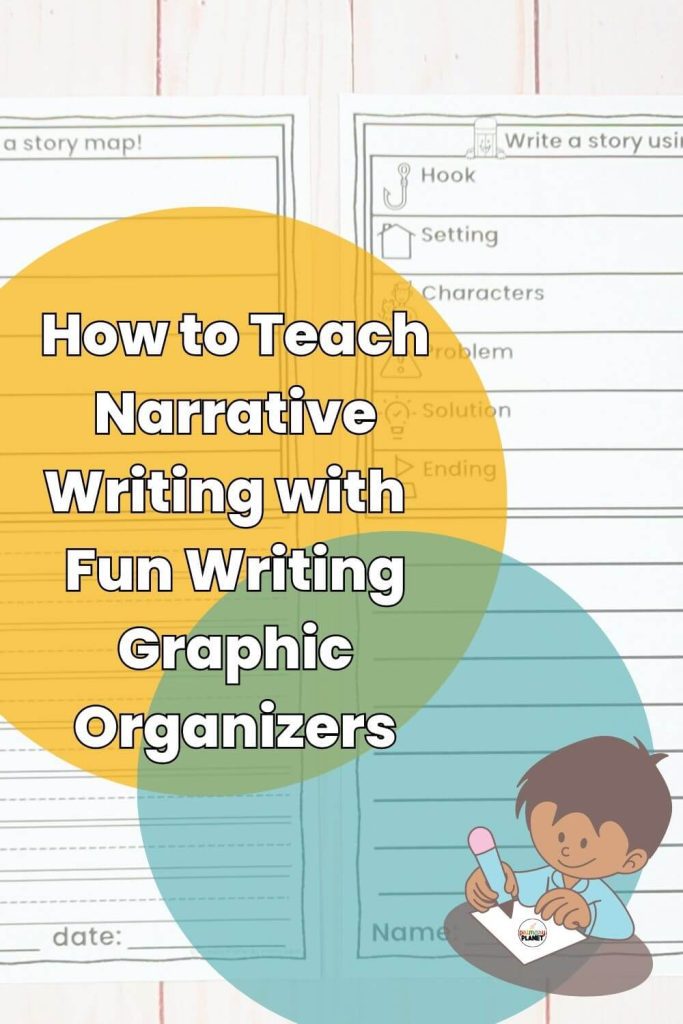
- Read more about: Writing
You might also like...

3 Fun Creative Writing Exercises for Your April Classroom Writing Center
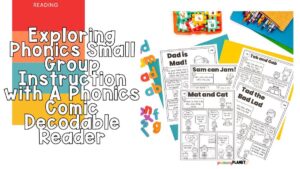
Exploring Phonics Small Group Instruction with a Phonics Comic Decodable Reader
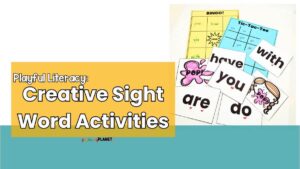
Playful Literacy: 9 +1 Creative Sight Word Activities You’ll Absolutely Love
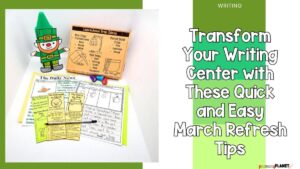
Transform Your Writing Center with These Quick and Easy March Refresh Tips
Look who's teaching happy, join the freebie planet.
Sign up for exclusive access to out of this world teachery stuff!
- Privacy Overview
- Strictly Necessary Cookies
- Cookie Policy
This website uses cookies so that we can provide you with the best user experience possible. Cookie information is stored in your browser and performs functions such as recognising you when you return to our website and helping our team to understand which sections of the website you find most interesting and useful.
Strictly Necessary Cookie should be enabled at all times so that we can save your preferences for cookie settings.
If you disable this cookie, we will not be able to save your preferences. This means that every time you visit this website you will need to enable or disable cookies again.
More information about our Cookie Policy

Learning-Loops
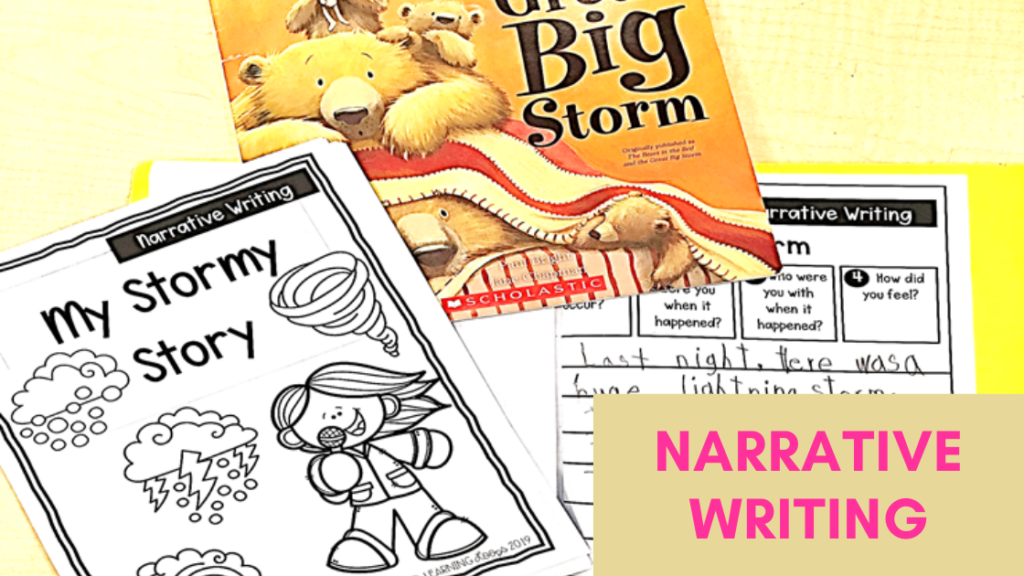
13 Graphic Organizers to Teach Narrative Writing
I always look forward to my Writers Workshop with my first graders. There is so much we want them to learn, however, we cannot teach all of it to them at once or we will make them hate writing forever. We also cannot expect them to write without equipping them with all the skills needed for a good piece of writing. Overwhelming young writers always puts brakes on their creativity and that is not what we want when we want them to write. As a teacher, it is our responsibility to help model and instruct on how to be better writers. I have compiled these graphic organizers to help make this process easy for you and your students.
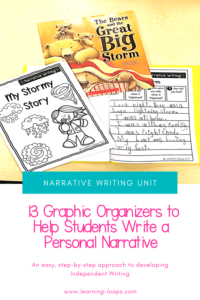
WHAT IS A NARRATIVE?
A narrative is a story! Narratives can be fictional or non-fictional and are told in order. Narratives are usually the first kind of writing that students do when they start writing. Narrative writing is usually easy for students because they are writing about themselves and events that have happened to them.
Here’s what I do when I teach students how to write narratives.
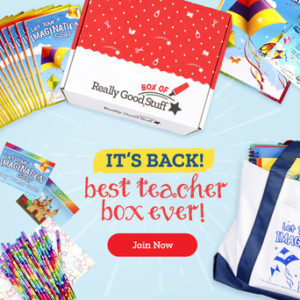
WHAT TO WRITE ABOUT?
Usually, when I start this unit, I provide them with a topic to write about and later, when they are more confident of their writing, I let them choose ideas to write about. For this particular unit, I chose to write a personal narrative about A STORMY DAY since they were learning about tornadoes and hurricanes.
MENTOR TEXT
It’s always best to use a mentor text whenever you are teaching your students to write any genre of writing. Luckily, we found the perfect book to go with our story topic. We read the book “ The Bears and the Great Big Storm” by Paul Bright which was thoroughly enjoyed by my firsties. I cannot stress enough on how great this book is to teach narrative writing since it had all what I wanted my students to learn.
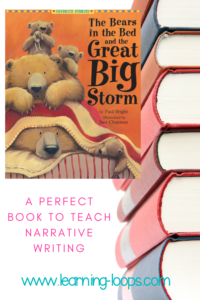
LET’S BEGIN THE WRITING PROCESS!!
We started off by choosing what kind of storm to write about. Students had the option to choose from lightning, rain, thunder, or snow storm.
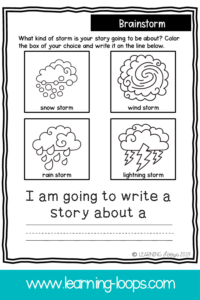
Next step was to determine the characters and setting for their stories. Who were they with on that stormy day and where were they?
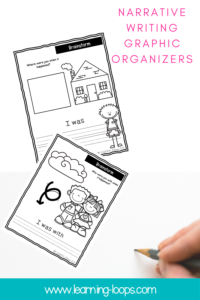
SHOW, NOT TELL
This skill is really important while teaching students how to write giving descriptive details and our mentor text book really helped us here to enable students to show their readers how severe the storm was and how they felt. Had it not been for this book, my students would not have been able to master this skill. The details they came up with while describing the storm and how they felt were enough to make me burst with pride.

ROCKIN’ BEGINNINGS AND JAMMIN’ CONCLUSIONS
Although you can teach a variety of ways to your students to begin and end their stories, however, I have found that teaching and sticking to one for a while helps students master that style before they can try a different style. We stuck to starting our stories with onomatopoeia which is always a hit and ending them with what they would do next time if there was a storm.
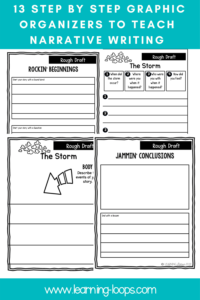
You can get these graphic organizers at my TpT Store or CLICK HERE .
If you want to check out my post about story starters for Apples Unit, CLICK HERE .
Leave a Reply Cancel reply
Your email address will not be published. Required fields are marked *
- For Teachers
- Schools & Districts
- Contact Sales
Narrative Writing Organizer
A graphic organizer used to plan and outline a narrative or story, including the setting, details, problem, key events and solution.
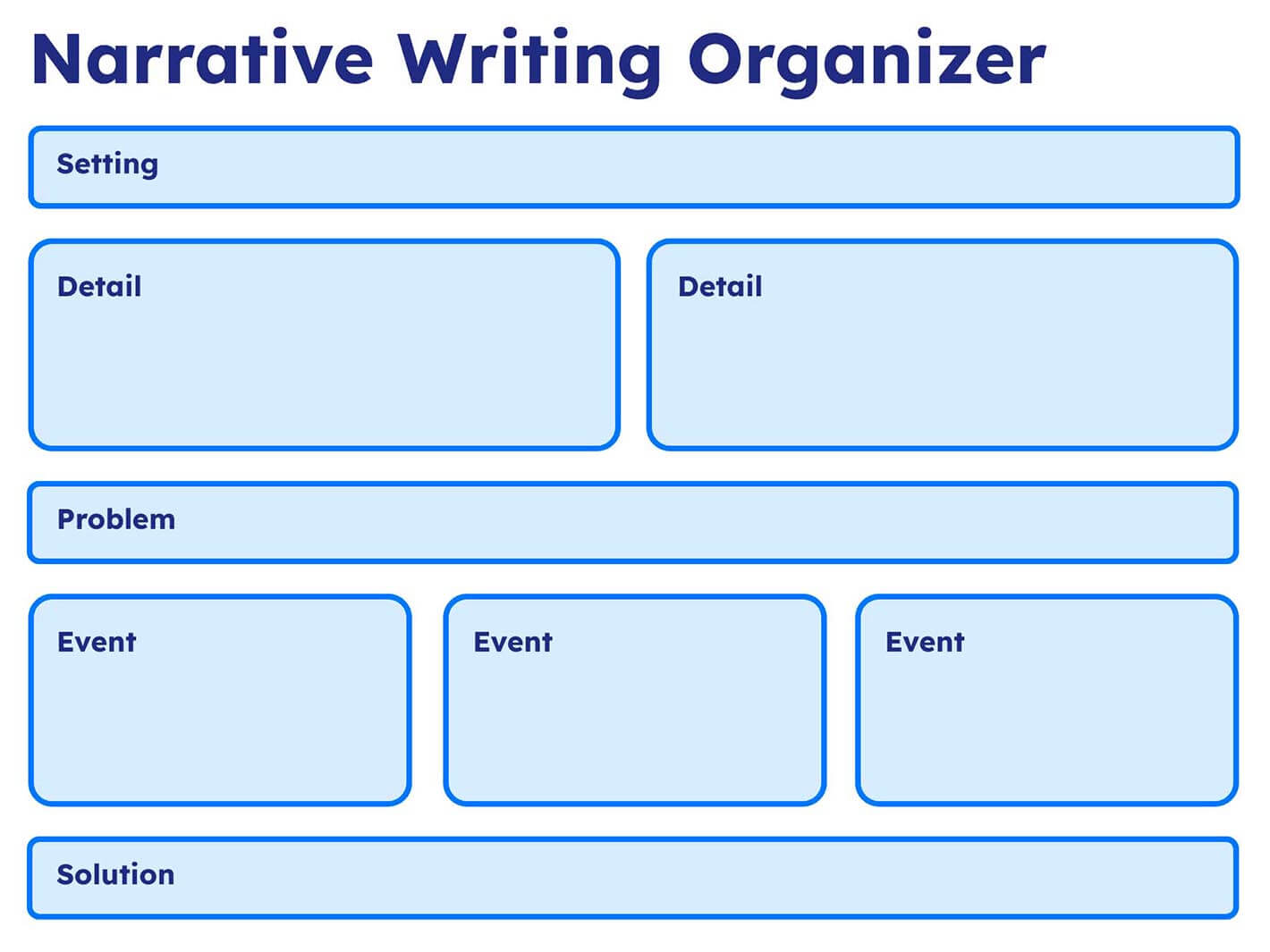
Description
- English Language Arts /
- character /
- narrative /
- organization /
- story map /
- summarize /
Discover Graphic Organizers

The graphic organizers are available in Book Creator’s built in App Store . Sign into Book Creator, simply enable the graphic organizer app, then you and your students can add your chosen organizers to your books.
10 graphic organizers are available to all users, with the full set of over 100 organizers available to teachers on a premium or schools and district plan.
Get the templates!
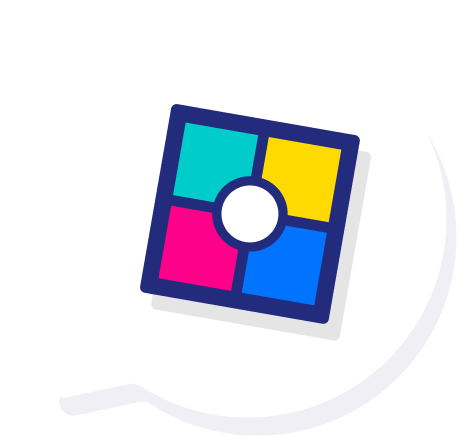
Looking for something? Type below…
- Create a FREE account

Narrative Writing | Narrative | graphic-organizers
The Narrative Writing Diamond
Read Time 2 mins | Mar 26, 2020 10:11:15 AM | Written by: Toolbox
We encourage students to use the Narrative Writing Diamond as a pre-writing graphic organizer to plan their narrative stories. This provides a simple, basic story plan on which to build. Student’s can use organizers like this to help them translate their story summary or pre-writing plan to a fully elaborated piece of writing. The Narrative Writing Diamond is needed to guide beginners through the development and the elaboration of a successful, entertaining narrative story.
The diamond is, essentially, a reminder of the shape and proportion that a successful story takes, as well as a reminder of the key skill elements needed for an entertaining piece of writing.
We suggest that each student have a copy of the Writing Diamond in their writing folders to help them organize and develop their stories, and that a copy is posted in the classroom at all times.
Remember – the diamond is not a rigid rule or formulaic pattern – rather, it is a basic guide to help students channel their creativity into what others recognize as story. In time, the diamond will disappear into the writing, providing shape and structure for their creative ideas.

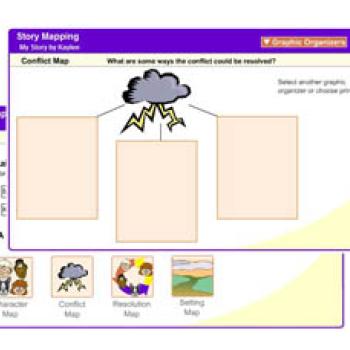
About this Interactive
Related resources.
The Story Map interactive includes a set of graphic organizers designed to assist teachers and students in prewriting and postreading activities. The organizers are intended to focus on the key elements of character, setting, conflict, and resolution development. Students can develop multiple characters, for example, in preparation for writing their own fiction, or they may reflect on and further develop characters from stories they have read. After completing individual sections or the entire organizer, students have the ability to print out their final versions for feedback and assessment. The versatility of this tool allows it to be used in multiple contexts.
- Student Interactives
- Calendar Activities
- Lesson Plans
The Plot Diagram is an organizational tool focusing on a pyramid or triangular shape, which is used to map the events in a story. This mapping of plot structure allows readers and writers to visualize the key features of stories.
The Graphic Map assists teachers and students in reading and writing activities by charting the high and low points related to a particular item or group of items, such as events during a day or chapters in a book.
The interactive Cube Creator helps students identify and summarize key elements. It can be used as a prewriting or postreading activity.
In this lesson students evaluate published children's picture storybooks. Students then plan, write, illustrate, and publish their own children's picture books.
Students are exposed to wordless picture books and begin developing story lines, both orally and in writing, using an online, interactive story map.
Cinderella without castles, coaches, or ball gowns? Students use versions of Cinderella to explore how the setting of a storytime, place, and cultureaffects the characters and plot.
Students hone their teamwork skills and play off each other's writing strengths as they participate in prewriting activities for a story to be written collaboratively by the whole class.
Students explore picture books to identify the characteristics of four types of conflict. They then write about a conflict they have experienced and compare it to a conflict from literature.
This lesson introduces students to William Shakespeare's Romeo and Juliet by having them examine the ideas of tragedy and tragic love by connecting the story to their own lives.
- Print this resource

Explore Resources by Grade
- Kindergarten K

Story Map Graphic Organizer: A Comprehensive Guide
6 minutes read
A story map graphic organizer is a powerful tool that aids writers and readers alike in navigating the complex elements of storytelling. By visually mapping out the key components of a narrative, a story map makes the process of crafting a well-structured story significantly more manageable. This comprehensive guide delves into the world of story map graphic organizers, their benefits, and how to utilize them effectively.
What is a Story Map Graphic Organizer?
A story map is a visual tool that uses a diagram to map out the key elements of a story or narrative. These elements typically include the setting, characters, conflict, plot progression (which can be further broken down into exposition, rising action, climax, falling action, and resolution), and theme.
By visually representing these elements, a Story Map Graphic Organizer helps students and writers to better understand and analyze a story. It aids in identifying relationships between different elements, recognizing narrative patterns, and predicting future events based on current plot progression.
Moreover, it can be particularly beneficial during the pre-writing stage as it assists in planning out a narrative effectively. By providing a clear outline of the story, it guides writers in developing a coherent and engaging narrative.
According to research by Boulineau et al. (2004), using graphic organizers like Story Maps can improve students' reading comprehension skills. Therefore, they are not only useful for writing but also for reading activities.
In conclusion, a Story Map Graphic Organizer is an invaluable tool for both reading and writing narratives. It simplifies complex narratives into understandable parts, making it easier to comprehend, analyze and create stories.
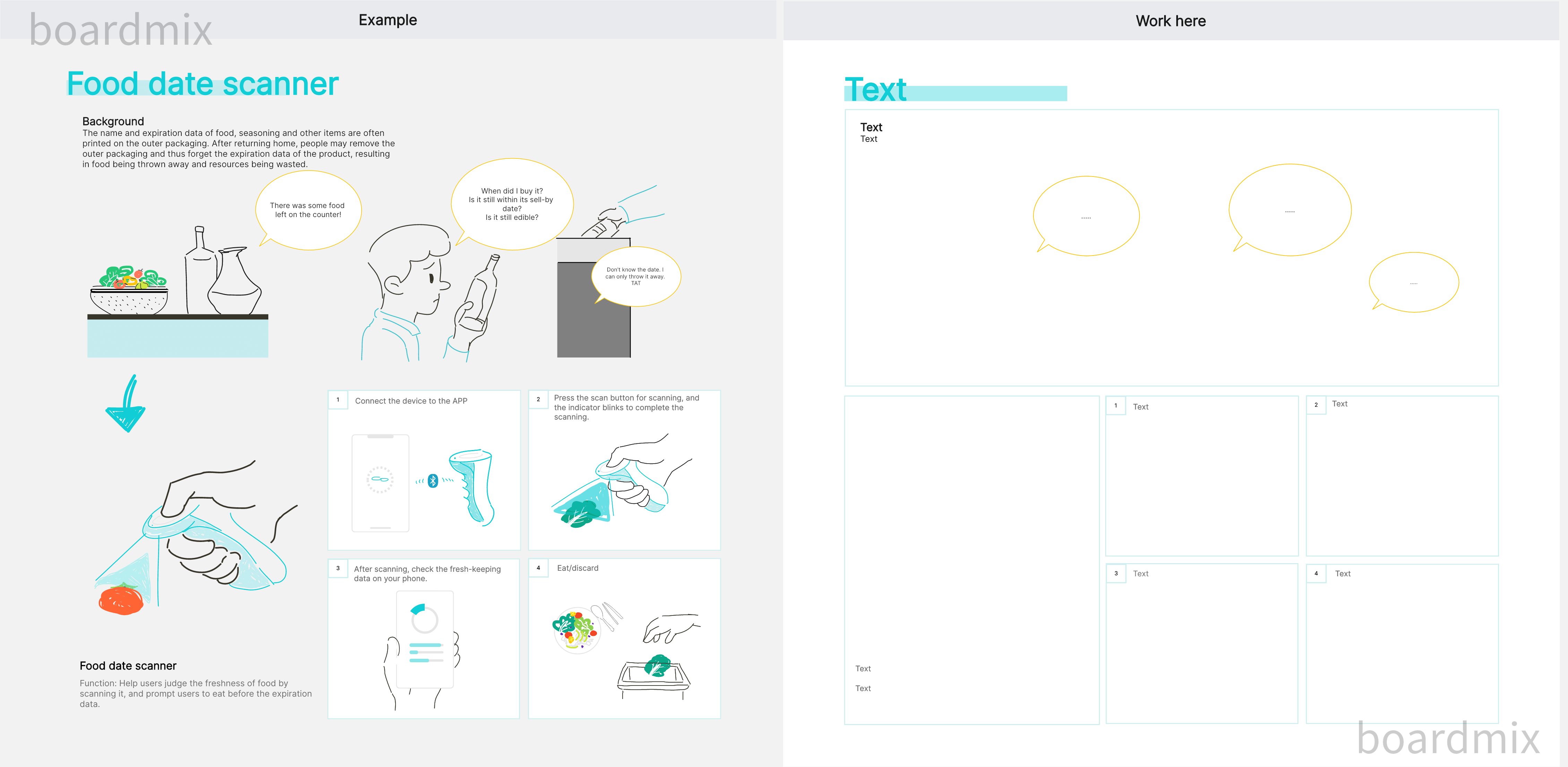
Benefits of Using a Story Map Graphic Organizer
- Enhanced Understanding: graphic organizer story map help in breaking down complex narratives into manageable parts, enhancing comprehension.
- Visual Aid: By providing a visual overview of the entire story, they assist in grasping the connections between different elements.
- Improved Writing Skills: Story maps serve as a blueprint for writing narratives, ensuring logical flow and coherence.
- Aid for Planning: They are effective tools for planning narratives as they provide an organized structure that outlines the entire story.
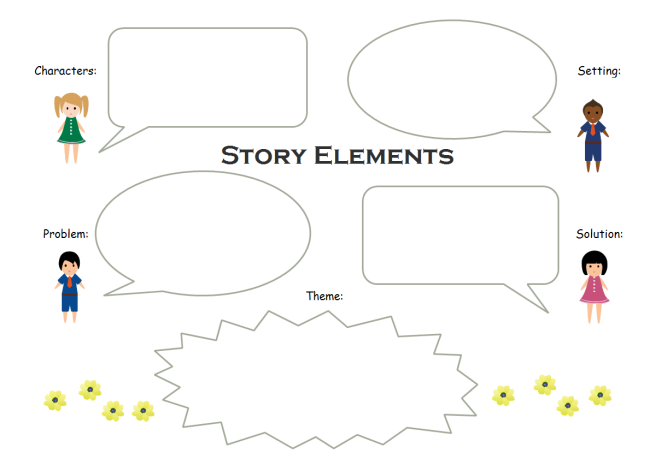
Types of Story Mapping Graphic Organizers
Story maps serve as a vital tool in understanding the anatomy of a story. By breaking down narratives into their key components, they aid in the comprehension, analysis, and composition of stories. While the central premise remains the same, story map graphic organizers come in different types to cater to varied narratives and usage requirements. Let's explore these types!
1. Basic Story Map
The most straightforward form of a story map includes a story's primary components - setting, characters, conflict, and resolution. This type is best suited for simple narratives or introducing beginners to story mapping.
2. Plot Diagram
This type takes a deeper dive into the plot structure. It divides the plot into exposition, rising action, climax, falling action, and resolution, creating a "mountain shape" diagram that visually depicts the story's progression.
3. Character Map
Focusing on character development, this organizer delves into the personality traits, motivations, relationships, and evolution of characters. It's a valuable tool for in-depth character analysis and development.
4. Conflict Map
Centered around the story's conflict, this organizer maps out the different conflicts in the story (internal/external) and how they're resolved. It helps in understanding how conflicts drive the story forward.
5. Theme Map
This type aims to identify and analyze the underlying themes of a narrative. It involves extracting symbols, motifs, quotes, and instances that point towards the theme.
6. Event Timeline
Chronologically mapping out key events in the narrative, this organizer acts as a visual timeline that aids in understanding the sequence of events and their impact on the story.
7. Multi-Story Comparison Map
Ideal for comparing and contrasting different narratives, this organizer overlaps elements from multiple stories to draw similarities or differences.
8. Interactive Digital Story Map
With technological advances, interactive digital story maps like those offered by Boardmix have become popular. They offer customizable templates and multimedia features to make story mapping more engaging and comprehensive.
How to Use the Boardmix Story Map Graphic Organizer?
The Boardmix Story Map Graphic Organizer is a revolutionary tool that enhances your narrative planning process. Whether you're an author, student, teacher, or professional storyteller, this powerful tool offers you a structured and engaging way to develop and outline your stories. So, how do you use this helpful feature? Let's find out!

Step 1: Accessing the Story Map Tool
Start by logging into your Boardmix account. Once you're in your dashboard, select the 'New Project' button. From the provided options, select 'Story Map Graphic Organizer'.

Step 2: Identify the Key Story Elements
Your first step inside the Story Map organizer should be to identify the critical components of your story. These include the setting, characters, main conflict, major events in the plot, and resolution. The Boardmix organizer will provide designated areas for each of these elements.
Step 3: Filling in the Details
Start populating each section of your story map with relevant details. Write about the setting, list down your characters, outline the main conflict, and detail the plot progression. The drag-and-drop functionality of Boardmix makes this process interactive and effortless.
Step 4: Incorporate Visuals
Make your story map more engaging and intuitive by adding visuals. You can use colors to differentiate between different characters or plot stages, insert images related to your setting or character looks, and add icons to symbolize different aspects of your story.
Step 5: Review and Refine
Once you've filled out your story map, review it thoroughly. Look for potential gaps in your plot, characters that need more development, or any inconsistencies. Boardmix allows for easy editing and refining, ensuring your story map remains fluid and adaptable.
Step 6: Collaborate
Invite others to view and edit your story map if you want feedback or are working as part of a team. Boardmix supports real-time collaboration, making it an effective tool for group projects.
Step 7: Use it as a Guide
Once you're satisfied with your story map, use it as a guide when writing your story. The clear structure and visual nature of the Boardmix Story Map Organizer make it an excellent reference throughout your writing process.
The Boardmix Story Map Graphic Organizer simplifies the often-daunting task of structuring a narrative. By allowing for a visual organization of thoughts and ideas, it makes the process of storytelling more manageable and enjoyable. Now that you know how to use it make the most of this tool and let your creativity soar!

Tips for Creating an Effective Story Map
- Keep it Simple: Your story map should be clear and easy to understand. Avoid cluttering it with too much detail.
- Use Visuals: Use symbols, colors, and other visual aids to make your story map more engaging and easy to navigate.
- Revise and Update: As your story evolves, make sure to revise and update your story map.
The story map graphic organizer is indeed an invaluable tool for anyone dealing with narratives, whether a writer crafting a new piece or a reader trying to comprehend an existing one. It provides structure to the otherwise complex process of narrative construction, making storytelling an easier and more enjoyable task. So the next time you embark on a narrative adventure, consider using a story map to guide you on your journey!
Join Boardmix to collaborate with your team.
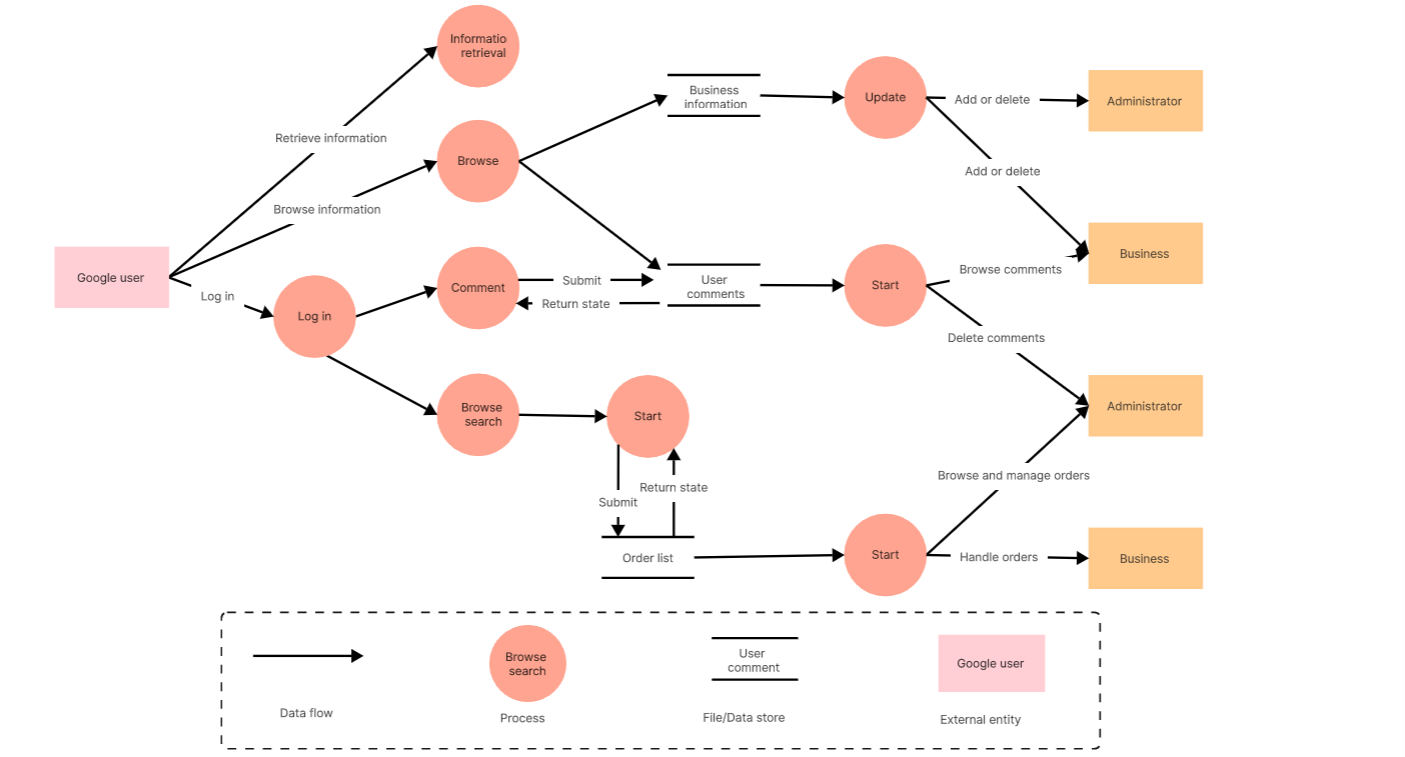
Creating Data Flow Diagrams Online: Step-by-Step Tutorial
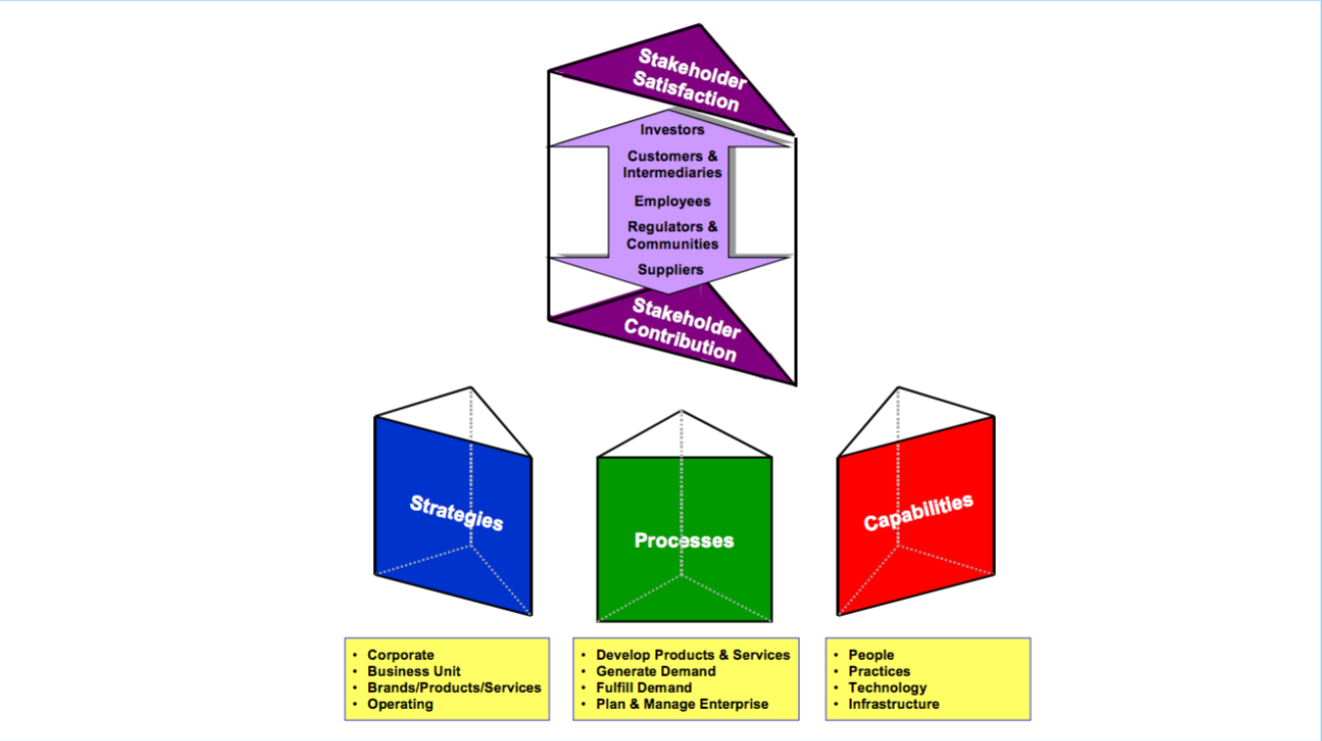
Demystifying the Performance Prism: A Comprehensive Guide
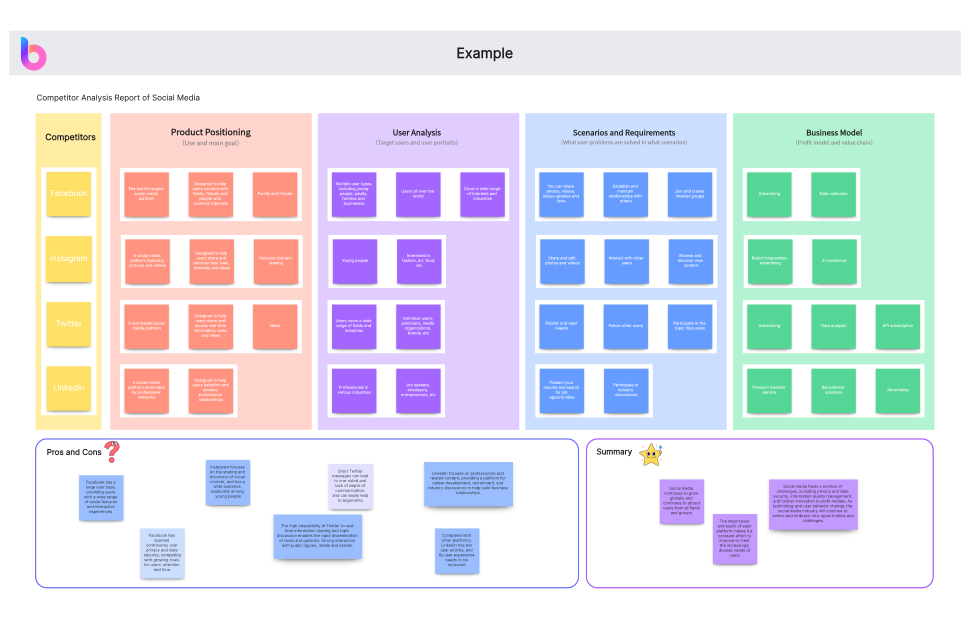
Mastering Competitive Analysis in Business Plan
All Formats
Resource types, all resource types.
- Rating Count
- Price (Ascending)
- Price (Descending)
- Most Recent
Free writing graphic organizers

Reading Comprehension Strategies MEGA Bundle + Differentiated Reading Passages!

Kindergarten Decodable Sentence Activities MEGA Bundle

Writing Units Bundle Narrative Opinion Persuasive Biography Informative
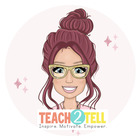
Be a Pal to Pigeons Activity Bundle
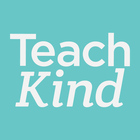
FREEBIE Venn Diagram w/lines
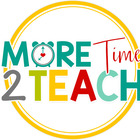
Opinion Writing Activities
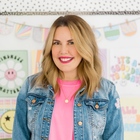
FREEBIE! Story Map - Setting, Characters, Beginning, Middle, End

Reading Responses
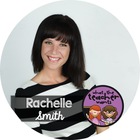
Personal Narrative Writing Materials FREEBIE | Graphic Organizers and MORE

Venn Diagram ~ Blank ~ FREEBIE!!
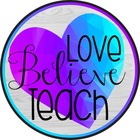
Story Elements Graphic Organizers FREE | PRINT + DIGITAL (Google Slides)

O.R.E.O Opinion/Persuasive Writing Graphic Organizers with Transition Word Lists
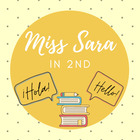
Opinion Writing Graphic Organizer | Argumentative Writing Template | Free
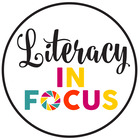
- Google Apps™
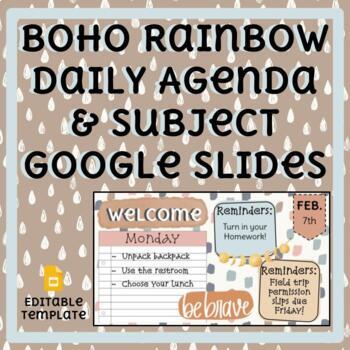
Boho Rainbow Daily Agenda and Subject Google Slides FREEBIE

- Google Slides™
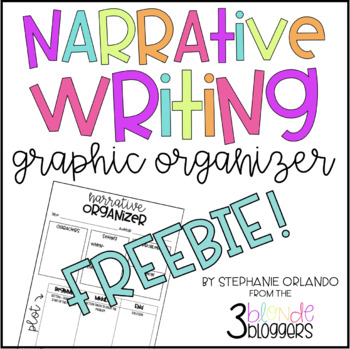
Narrative Writing Graphic Organizer
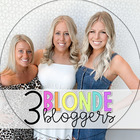
How To Writing Paper Template
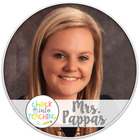
Main Idea Graphic Organizer for Students

Free Four Square Vocabulary Worksheet | Vocab Graphic Organizer Activity
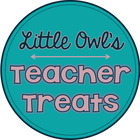
Biography Graphic Organizer - Elementary

Free Narrative Writing Prompt for Paragraph and Essay

Comic Strip Template FREEBIE!

- Easel Activity
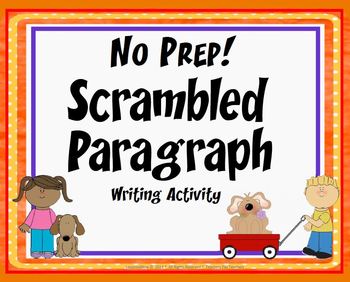
Scrambled Paragraph Writing Activity
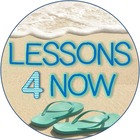
Free Personal Narrative Writing Prompts First Grade Writer's Workshop Activities

Earth Day Free
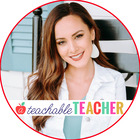
Animal Research template (freebie)

Argumentative Essay Writing Resources: Persuasive Essay Graphic Organizer

Story Map Graphic Organizer

The Good Egg Read Aloud FREE - Reading Comprehension Activities

Find Writing resources | TPT
Learn more about writing resources.
Writing worksheets can help your child develop essential writing and literacy skills needed for school and life. If you’re a teacher or parent looking for printable and digital writing resources to help your student learn a writing concept, look no further! TPT has an extensive collection of resources, created by other teachers, that are designed to help with any need across grade levels.
For elementary students who are just learning to write, you can use worksheets to practice letter formation. Students in middle and high school can use learning stations to learn how to write and revise essays. With plenty of TPT resources at your fingertips, you can sharpen your student's writing skills in no time. Extend writing activities beyond the classroom and observe as your child nurtures their imagination, enriches their vocabulary, and enhances their storytelling prowess.
Fun and engaging writing activities to try
Here are a few ideas for writing activities — from our teacher-created resources — that you can find on TPT and that are designed to teach students how to write effectively. (Pro tip: These worksheets serve as an excellent complement to our reading materials.)
Encourage students to keep daily journals where they can freely express their thoughts, feelings, and experiences. This practice helps them develop their writing style and build the habit of writing regularly.
Writing Prompts
Provide engaging prompts that encourage imaginative storytelling. For instance, you could ask students to write about a world without the internet, or ask them to describe something only using one of their five senses (sight, sound, smell, touch, or taste).
Peer Editing
Have students exchange their written work with a peer for feedback. This helps them strengthen their ability to identify and correct mistakes in grammar, punctuation, and spelling; give constructive criticism; and revise their writing based on feedback.
Sentence and Paragraph Construction
Provide sentence and paragraph building exercises to help students understand the basic structure of writing and how to organize their ideas coherently.
Letter Writing
Ask students to write letters to real or fictional recipients. They could compose formal letters, persuasive letters on specific topics, thank-you notes, or postcards.
Create a classroom blog where students can publish their writing for a wider audience. This teaches them to write for a purpose and consider their audience's perspective.
Research Papers
Guide students through the process of researching and writing informative or argumentative essays. Teach them how to construct persuasive arguments and counterarguments on various topics, include evidence, and cite sources.
Poetry Writing
Explore different forms of poetry, such as haikus, sonnets, and free verse. Encourage students to experiment with imagery, rhythm, and metaphor.
By incorporating these (and other!) writing activities into your lesson plans, you can nurture a love for writing.
Frequently asked questions about teaching writing
What types of writing resources are available on tpt.
There are many different types of writing resources sold by Sellers on TPT. Some popular writing lessons include creative writing, poetry, writing essays, writing expository, and handwriting.
How do I find writing lessons on TPT?
Educators can save time preparing writing lessons with resources created by experienced teachers. Simply start a search for writing resources on the TPT marketplace, and filter by grade level, price, and/or resource type to find materials that've been proven to work in classrooms like yours. No matter what you’re teaching, there are plenty of writing lessons and activities sold by Sellers on TPT that are tailored to meet your students' skill levels.
- We're hiring
- Help & FAQ
- Privacy policy
- Student privacy
- Terms of service
- Tell us what you think
- Our Mission
Planning Writing Lessons for the Early Elementary Grades
Teachers can provide thoughtful instruction that supports the sustained development of young students’ literacy skills.

Often, attempting to plan effective and purposeful writing instruction raises many questions: What does lesson planning look like? How will I manage so many students who may be in different stages of their writing? How often should they be editing and revising? The list doesn’t stop there.
By utilizing on-demand writing for assessment and long-range writing for scaffolded practice of applying various writing techniques, teachers can approach their instruction with intentional and tailored lessons that meet the needs of the learners in the classroom, as well as help students develop self-regulated behaviors when crafting a piece of text.
On-Demand Writing
Just like any area of instruction, assessment is critical for knowing what the students’ strengths and areas of growth are, and on-demand writing is how teachers can gather that evidence. An on-demand piece of writing simply means that the teacher provides a specific prompt for the student to write to for the purpose of anecdotal data. For example, let’s say a second-grade teacher prepares for a narrative writing cycle. In the first couple of days before the cycle begins, they’ll ask students to write a narrative about something fun they’ve experienced (with their family or a friend).
After the prompt is given, students get one or two days to write and are provided with all necessary tools to carry out the process of developing a piece of writing without additional modeling or instruction. Effective tools might include graphic organizers, writing paper, tools for editing, and a writing checklist. However, the teacher will not model how to use the tools. The teacher is informally assessing if the students know how to use these resources to develop a story.
After students complete their piece, the teacher collects them for analysis. It is critically important to determine realistic expectations for what writing should look like throughout various points of the year, so creating a common rubric as a grade level is a great way to stay on the same page for analyzing the assessment.
Writing growth, similar to reading, happens along a continuum of skills. At the beginning of the year, a second grader can’t be expected to write like an end-of-the-year second grader because they haven’t been taught the grade-level skills necessary to do so yet. On-demand benchmark assessments along the way will gradually raise the expectation of what that student should be able to do. Websites such as Reading Rockets and Achieve the Core provide useful anchor examples of real student writing in various genres that provide annotated explanations of students’ overall writing ability and possible next steps for instruction.
As students engage in daily lessons about crafting a narrative within the instructional cycle of a long-range writing piece, another on-demand prompt may be given at the halfway point of the cycle to track growth and drive future instruction. This could be the same prompt as before or a prompt given in response to a story or passage the student has read.
It’s important to remember that it’s easy to fall into the trap of using writing prompts daily for students to produce writing simply because it’s easy to manage. If we use this approach exclusively, we rob our students of the opportunity to dive deeply into producing self-chosen, elaborate pieces full of voice and author’s craft.
Long-Range Writing
Long-range pieces give students the autonomy to choose their own writing topic while the teacher assists in walking them through the process. This type of instruction instills the executive-functioning behaviors needed when students are asked to write a piece on demand. When considering how to implement this type of writing instruction, it can be overwhelming. Breaking down long-range instruction using the following components allows for a more manageable approach.
Keep your lesson mini: A mini lesson is 15 to 20 minutes long and organized in a gradual release format, and it allows the teacher to model a specific, focused lesson. For example, narrative writing could be broken into the following mini lessons for a beginning-of-the-year cycle for second grade: introduce and describe a setting, introduce and describe the character, edit on the go (this means to stop and edit before we add more writing), describe the first event in the narrative, introduce a problem, etc. Essentially, each lesson will invite students to add to their story one chunk at a time.
Model, provide independent practice: The teacher begins by modeling one learning target using a well-crafted organizer . An effective organizer teaches students that each genre has a specific structure. As learners begin to recognize the pattern in text structure, they can replicate it when assessed in on-demand pieces. For example, the teacher can start by using a text that clearly introduces and describes the setting, and then read that page out loud and ask students what they notice about how the author introduced the setting.
Next, students are invited to help the teacher write a setting to a story together by offering verbal suggestions. The teacher records the students’ ideas and writes an example introduction in the organizer. Then students think about an idea for an introduction of a setting on their own and are prompted to talk to a partner about their story. The students verbally rehearse what they plan to write, as this provides them an opportunity to organize their thoughts and prepares them to get started as soon as they are released to write independently, using the same organizer that the teacher used to model the mini lesson.
The benefit of this approach is that it gives the teacher time to provide specific feedback over the same crafting element. Having every student write their complete thoughts directly in the organizer in a chunked manner allows for a better visual of where to correct capitalization and punctuation. Essentially, each lesson should invite students to write one or two complete sentences that can be quickly edited before adding the next part of the story.
Share and reflect: Close each lesson by bringing students back together so that they have an opportunity to share what they’ve produced. This time celebrates students’ creativity, as well as giving them an opportunity to reflect on how they can improve their writing.
Both on-demand writing and long-range writing are vital in developing confident writers across various genres. It’s important to approach them with a cyclical scope and sequence that allows students to learn the craft, structure, and development of narrative, informative, and opinion styles of writing. By scaffolding and supporting students’ growth in each genre of writing, learners will begin to automatically apply these techniques more independently as the year progresses because of the solid foundation that has been built.

IMAGES
VIDEO
COMMENTS
Theme Concept Map. The next graphic organizer is focused on the concept of theme. In order for students to start thinking about possible themes ahead of time, I like to complete it with students before they start writing. If students are clear on their theme, their stories tend to have more depth and meaning.
Example 6: Graphic Organizer for Narrative Writing. A graphic organizer for narrative writing is a perfect solution for young students in the early grades. This narrative writing graphic organizer is the simplest form of an organizer. It starts with the title, topic, and purpose. Then we ask the students to write the first catching sentence.
A story map is a graphic organizer that helps students learn the elements of a narrative. Learning to identify a story's characters, plot, setting, problem, and solution prompts students to read carefully to learn the important details. There are many different types of story maps. The most basic ones focus on the beginning, middle, and end ...
WRITING ORGANIZER - Narrative Complication: Dilemma or problem that sets off the events Sequence of events: Triggered by the complication Resolution: Climax or ending where the problem is resolved Usually includes: -When-Where-Who or what A dilemma or problem which disrupts the normal life or comfort of the characters and sets off a sequence of
Creativity + Structure = Success. Some may argue that graphic organizers will limit the creativity of students when writing a narrative. My response: understanding and applying the basics of story structure is important. I want my students' amazing output to be understood by their readers. For most students, a great deal of scaffolding is ...
The Best Graphic Organizer for Narrative Writing: Step 6 - Plot Diagram or Story Map. Teachers use these graphic organizers when reading narratives all the time. They are also a popular choice for teaching writing narratives. I know that some people use these upcoming terms interchangeably, which is fine.
This organizer can also be just as easily used, now that this student is familiar with story structure and how to use this particular organizer, to create his own original story. The best graphic organizers are open-ended enough to be used for both reading and writing with narrative and informational texts!
Encourage them to be descriptive, painting a vivid picture for the reader, even while creating their narrative writing graphic organizer. Conflict and Resolution: Help students identify the central conflict in their narrative and a section for how it gets resolved. This will ensure the story has a clear, satisfying conclusion for readers.
This Story Writing Graphic Organizer is the key to starting strong so that what they're writing is built on a solid, fully fleshed-out structure. The Story Graphic Organizer features sections ranging from the setting to the solution and covers the classic beginning, middle, and end. In a single sheet, your learners can hit the important ...
Graphic Organizers! In this blog post, we'll explore the benefits of using graphic organizers in the classroom and show you how to leverage them to improve your students' narrative writing abilities. From types of organizers to tips for effective implementation, we'll cover everything you need to know to empower your young writers.
The story mountain narrative planning graphic organizer will help develop the suspense as you lead into the story. •Graphic Organizer for Narrative Writing. Beginning, Middle, End Story Planning Page. This is a well worn planning format for narratives. It is basic but essential. some students focus on their complication and forget to bring it ...
Look no further! The Narrative Writing Graphic Organizer is the perfect resource for you and your young learners. This sheet has been thoughtfully designed to maximize creativity and provide a clear structure. Start by naming the characters and choosing the setting, then carefully plot the narrative until it reaches its climax and conclusion.
15 different graphic organizers for narrative writing! This is a great resource for helping students to plan and organize their narratives. Each organizer is Common Core aligned and created to seamlessly guide students through the narrative writing process. Printable, editable, and digital template...
A narrative is a story! Narratives can be fictional or non-fictional and are told in order. Narratives are usually the first kind of writing that students do when they start writing. Narrative writing is usually easy for students because they are writing about themselves and events that have happened to them.
Sign into Book Creator, simply enable the graphic organizer app, then you and your students can add your chosen organizers to your books. 10 graphic organizers are available to all users, with the full set of over 100 organizers available to teachers on a premium or schools and district plan.
This free graphic organizer is perfect for planning a narrative writing piece. This resource provides your students with a place to add the characters, setting (when and where), problem, and solution of their narrative. There are also boxes provided to add the plot of the story (beginning, middle, and end). I have included 4 versions of this ...
We encourage students to use the Narrative Writing Diamond as a pre-writing graphic organizer to plan their narrative stories. This provides a simple, basic story plan on which to build. Student's can use organizers like this to help them translate their story summary or pre-writing plan to a fully elaborated piece of writing.
The Story Map interactive includes a set of graphic organizers designed to assist teachers and students in prewriting and postreading activities. The organizers are intended to focus on the key elements of character, setting, conflict, and resolution development. Students can develop multiple characters, for example, in preparation for writing ...
Kindergarten and 1st Grade Graphic Organizers. In kindergarten and 1st grade, your students are just beginning to be introduced to the world of language arts and writing.They don't quite have the skills to formulate and organize a complete piece of writing on their own, but they do have original thoughts and ideas that they can start to express on paper.
A story map graphic organizer is a powerful tool that aids writers and readers alike in navigating the complex elements of storytelling. By visually mapping out the key components of a narrative, a story map makes the process of crafting a well-structured story significantly more manageable. This comprehensive guide delves into the world of ...
This is a brilliant resource to help children with their narrative writing skills. This narrative writing template is brilliantly structured to help children construct their writing perfectly. This simply designed organiser is perfect for children between the ages of 6-11 to structure and plan their writing well. Narrative writing can be a challenging topic to get the hang of but this ...
Then draw three lines from the inner to the outer circle as seen in the above example. For your prewriting, start in the middle of the circle and work your way out. In the center circle, write the topic of your personal narrative. I used the dryer story for all of these prewritings, so mine says "dryer incident.".
This free graphic organizer is perfect for planning a narrative writing piece. This resource provides your students with a place to add the characters, setting (when and where), problem, and solution of their narrative. There are also boxes provided to add the plot of the story (beginning, middle, and end).
Effective tools might include graphic organizers, writing paper, tools for editing, and a writing checklist. However, the teacher will not model how to use the tools. The teacher is informally assessing if the students know how to use these resources to develop a story.